Civil Engineering Assignment Solution
VerifiedAdded on 2021/06/17
|27
|7199
|23
AI Summary
Contribute Materials
Your contribution can guide someone’s learning journey. Share your
documents today.
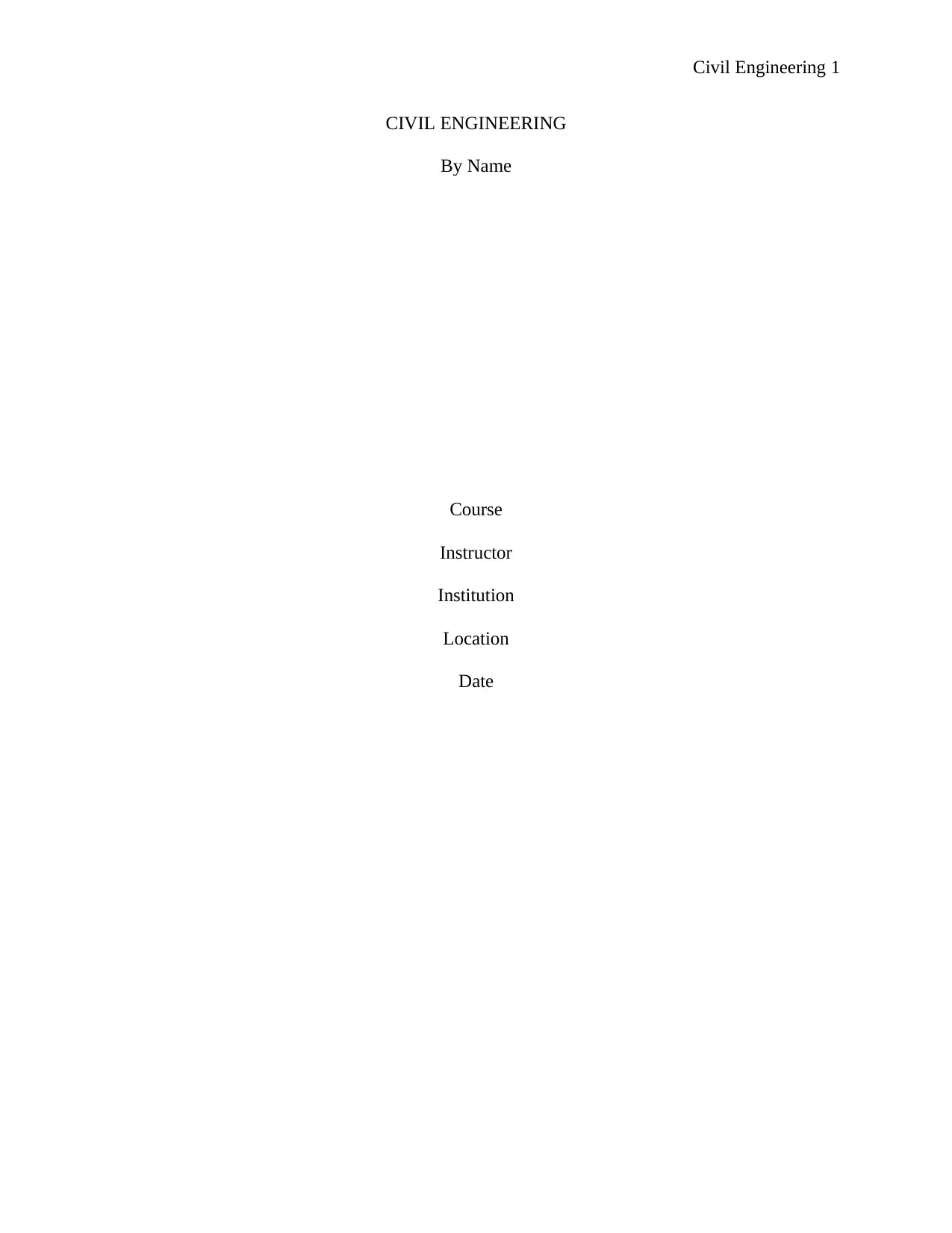
Civil Engineering 1
CIVIL ENGINEERING
By Name
Course
Instructor
Institution
Location
Date
CIVIL ENGINEERING
By Name
Course
Instructor
Institution
Location
Date
Secure Best Marks with AI Grader
Need help grading? Try our AI Grader for instant feedback on your assignments.
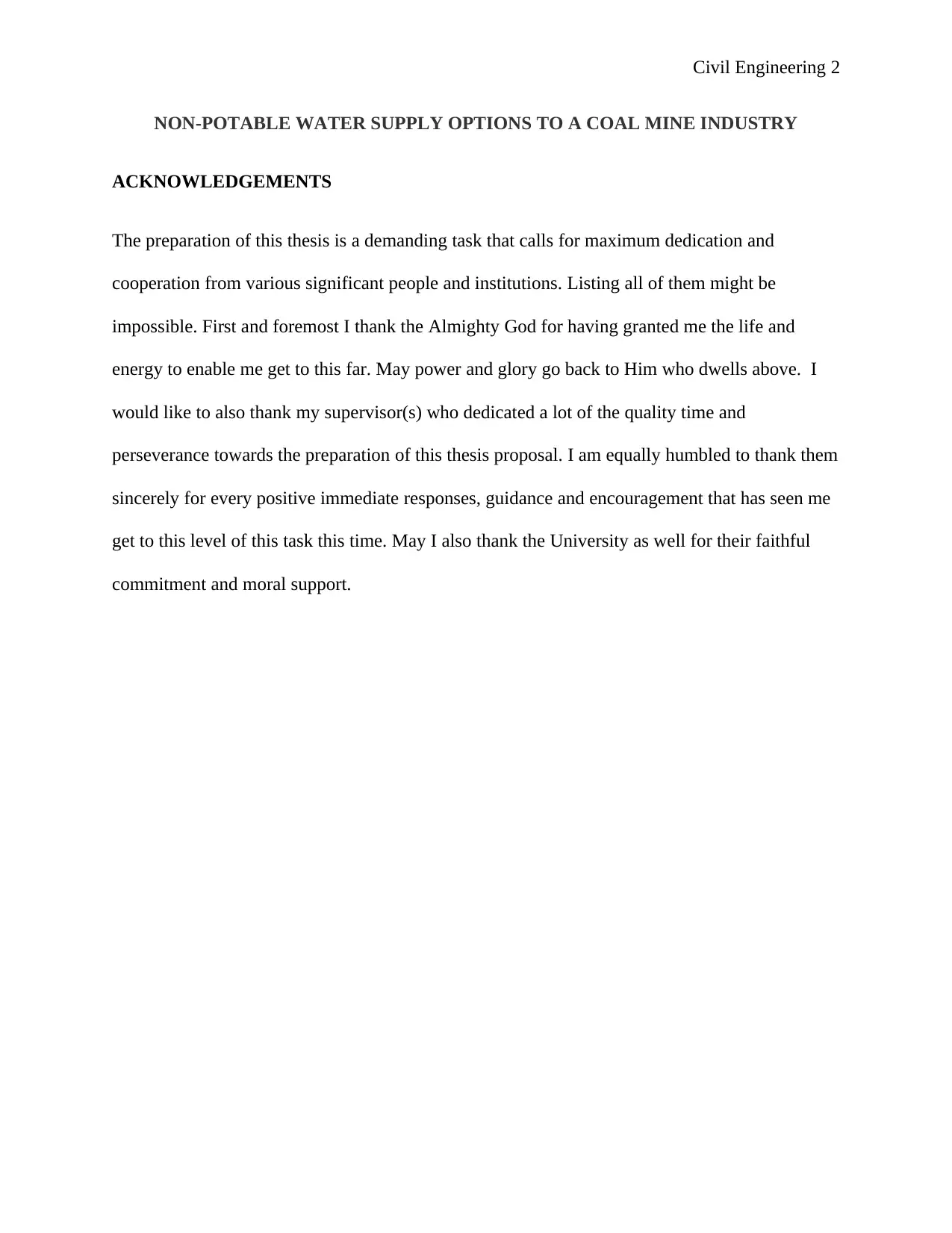
Civil Engineering 2
NON-POTABLE WATER SUPPLY OPTIONS TO A COAL MINE INDUSTRY
ACKNOWLEDGEMENTS
The preparation of this thesis is a demanding task that calls for maximum dedication and
cooperation from various significant people and institutions. Listing all of them might be
impossible. First and foremost I thank the Almighty God for having granted me the life and
energy to enable me get to this far. May power and glory go back to Him who dwells above. I
would like to also thank my supervisor(s) who dedicated a lot of the quality time and
perseverance towards the preparation of this thesis proposal. I am equally humbled to thank them
sincerely for every positive immediate responses, guidance and encouragement that has seen me
get to this level of this task this time. May I also thank the University as well for their faithful
commitment and moral support.
NON-POTABLE WATER SUPPLY OPTIONS TO A COAL MINE INDUSTRY
ACKNOWLEDGEMENTS
The preparation of this thesis is a demanding task that calls for maximum dedication and
cooperation from various significant people and institutions. Listing all of them might be
impossible. First and foremost I thank the Almighty God for having granted me the life and
energy to enable me get to this far. May power and glory go back to Him who dwells above. I
would like to also thank my supervisor(s) who dedicated a lot of the quality time and
perseverance towards the preparation of this thesis proposal. I am equally humbled to thank them
sincerely for every positive immediate responses, guidance and encouragement that has seen me
get to this level of this task this time. May I also thank the University as well for their faithful
commitment and moral support.
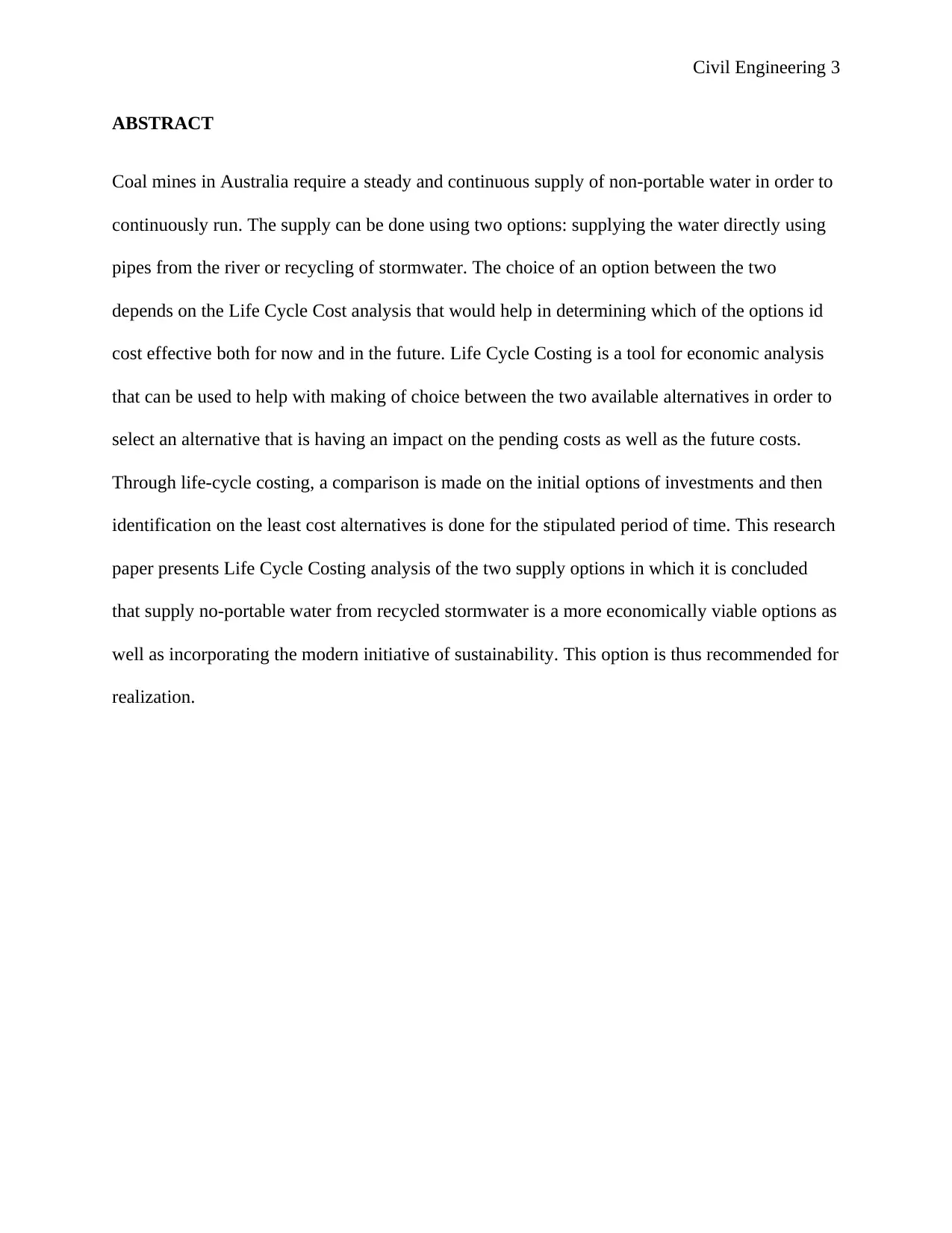
Civil Engineering 3
ABSTRACT
Coal mines in Australia require a steady and continuous supply of non-portable water in order to
continuously run. The supply can be done using two options: supplying the water directly using
pipes from the river or recycling of stormwater. The choice of an option between the two
depends on the Life Cycle Cost analysis that would help in determining which of the options id
cost effective both for now and in the future. Life Cycle Costing is a tool for economic analysis
that can be used to help with making of choice between the two available alternatives in order to
select an alternative that is having an impact on the pending costs as well as the future costs.
Through life-cycle costing, a comparison is made on the initial options of investments and then
identification on the least cost alternatives is done for the stipulated period of time. This research
paper presents Life Cycle Costing analysis of the two supply options in which it is concluded
that supply no-portable water from recycled stormwater is a more economically viable options as
well as incorporating the modern initiative of sustainability. This option is thus recommended for
realization.
ABSTRACT
Coal mines in Australia require a steady and continuous supply of non-portable water in order to
continuously run. The supply can be done using two options: supplying the water directly using
pipes from the river or recycling of stormwater. The choice of an option between the two
depends on the Life Cycle Cost analysis that would help in determining which of the options id
cost effective both for now and in the future. Life Cycle Costing is a tool for economic analysis
that can be used to help with making of choice between the two available alternatives in order to
select an alternative that is having an impact on the pending costs as well as the future costs.
Through life-cycle costing, a comparison is made on the initial options of investments and then
identification on the least cost alternatives is done for the stipulated period of time. This research
paper presents Life Cycle Costing analysis of the two supply options in which it is concluded
that supply no-portable water from recycled stormwater is a more economically viable options as
well as incorporating the modern initiative of sustainability. This option is thus recommended for
realization.
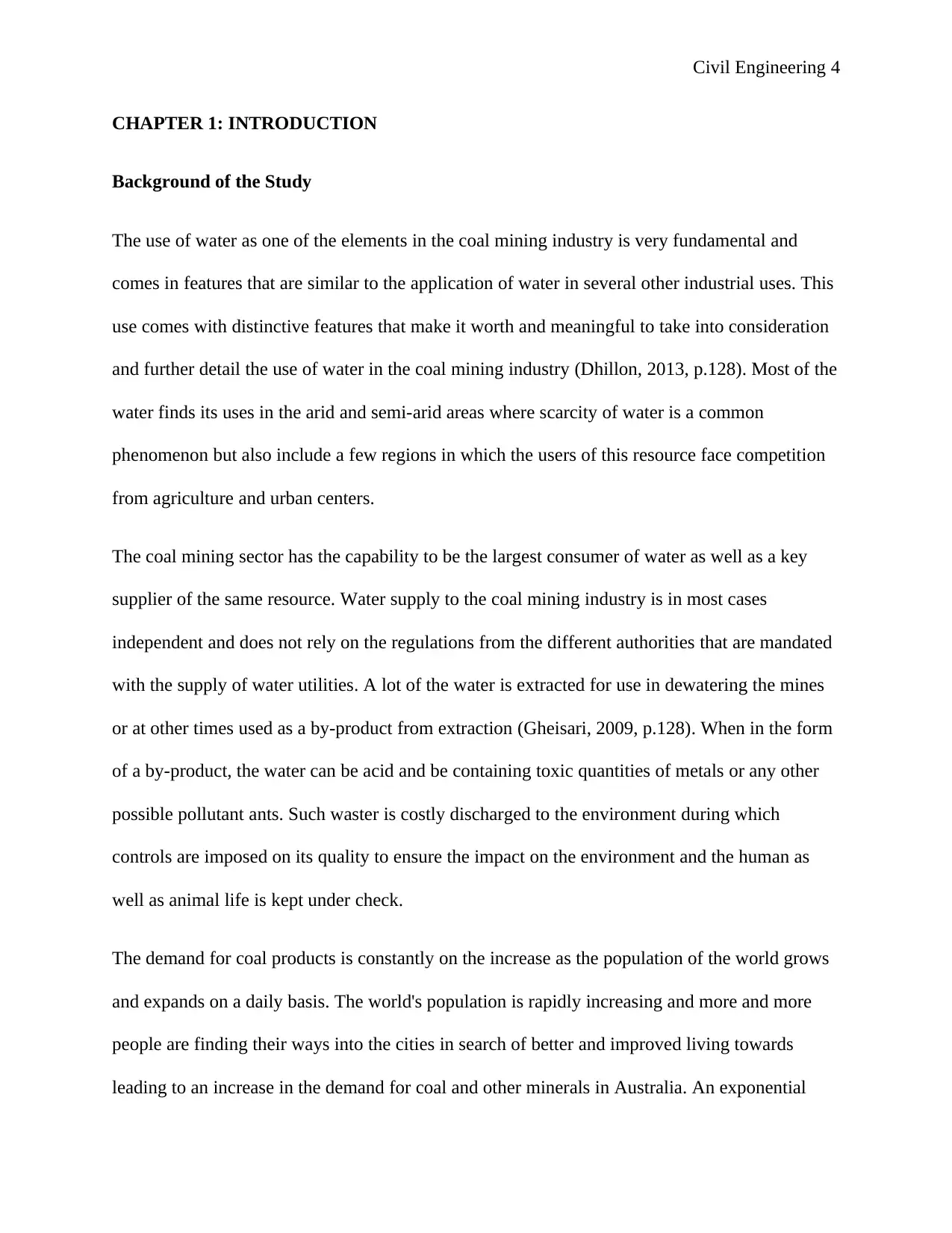
Civil Engineering 4
CHAPTER 1: INTRODUCTION
Background of the Study
The use of water as one of the elements in the coal mining industry is very fundamental and
comes in features that are similar to the application of water in several other industrial uses. This
use comes with distinctive features that make it worth and meaningful to take into consideration
and further detail the use of water in the coal mining industry (Dhillon, 2013, p.128). Most of the
water finds its uses in the arid and semi-arid areas where scarcity of water is a common
phenomenon but also include a few regions in which the users of this resource face competition
from agriculture and urban centers.
The coal mining sector has the capability to be the largest consumer of water as well as a key
supplier of the same resource. Water supply to the coal mining industry is in most cases
independent and does not rely on the regulations from the different authorities that are mandated
with the supply of water utilities. A lot of the water is extracted for use in dewatering the mines
or at other times used as a by-product from extraction (Gheisari, 2009, p.128). When in the form
of a by-product, the water can be acid and be containing toxic quantities of metals or any other
possible pollutant ants. Such waster is costly discharged to the environment during which
controls are imposed on its quality to ensure the impact on the environment and the human as
well as animal life is kept under check.
The demand for coal products is constantly on the increase as the population of the world grows
and expands on a daily basis. The world's population is rapidly increasing and more and more
people are finding their ways into the cities in search of better and improved living towards
leading to an increase in the demand for coal and other minerals in Australia. An exponential
CHAPTER 1: INTRODUCTION
Background of the Study
The use of water as one of the elements in the coal mining industry is very fundamental and
comes in features that are similar to the application of water in several other industrial uses. This
use comes with distinctive features that make it worth and meaningful to take into consideration
and further detail the use of water in the coal mining industry (Dhillon, 2013, p.128). Most of the
water finds its uses in the arid and semi-arid areas where scarcity of water is a common
phenomenon but also include a few regions in which the users of this resource face competition
from agriculture and urban centers.
The coal mining sector has the capability to be the largest consumer of water as well as a key
supplier of the same resource. Water supply to the coal mining industry is in most cases
independent and does not rely on the regulations from the different authorities that are mandated
with the supply of water utilities. A lot of the water is extracted for use in dewatering the mines
or at other times used as a by-product from extraction (Gheisari, 2009, p.128). When in the form
of a by-product, the water can be acid and be containing toxic quantities of metals or any other
possible pollutant ants. Such waster is costly discharged to the environment during which
controls are imposed on its quality to ensure the impact on the environment and the human as
well as animal life is kept under check.
The demand for coal products is constantly on the increase as the population of the world grows
and expands on a daily basis. The world's population is rapidly increasing and more and more
people are finding their ways into the cities in search of better and improved living towards
leading to an increase in the demand for coal and other minerals in Australia. An exponential
Secure Best Marks with AI Grader
Need help grading? Try our AI Grader for instant feedback on your assignments.
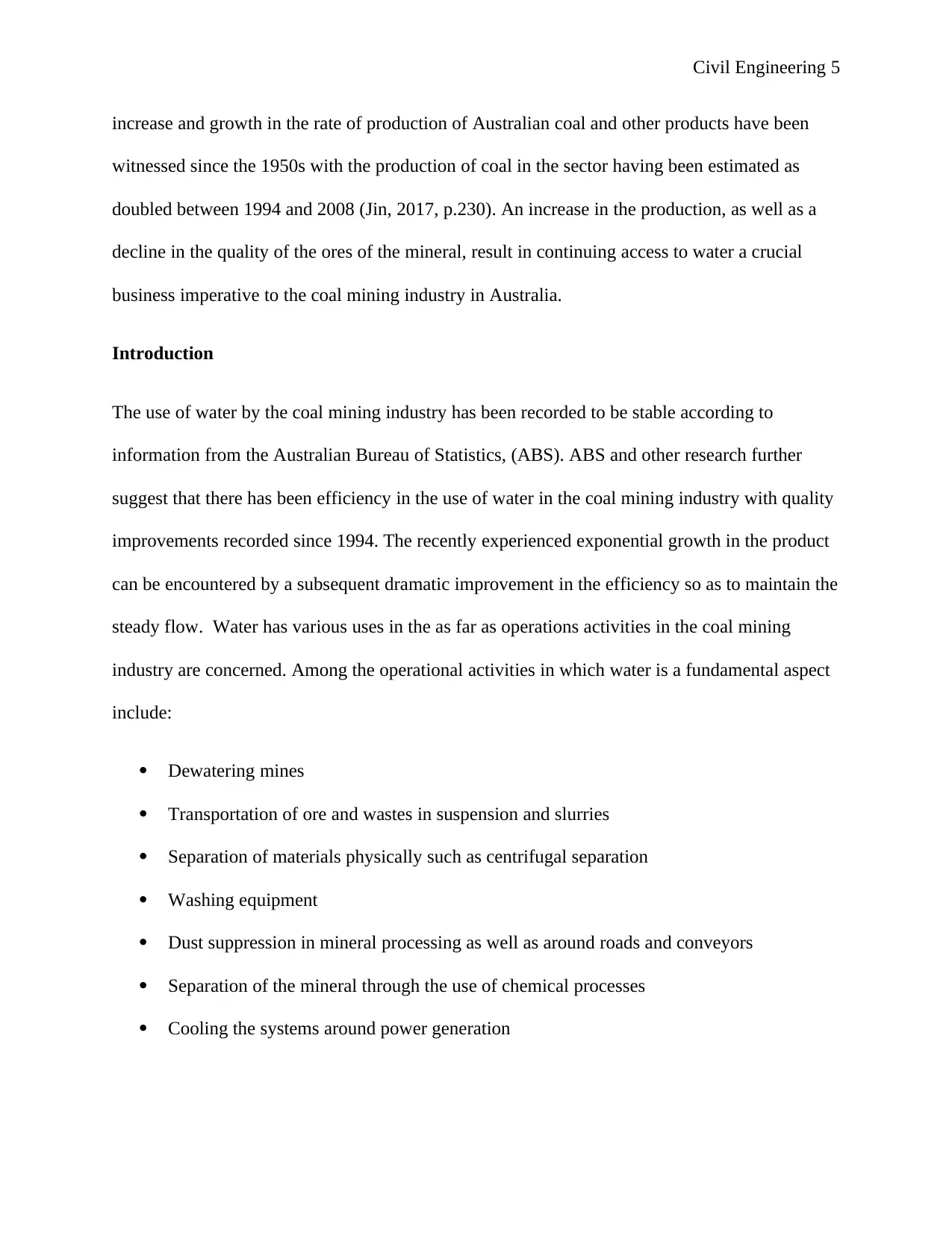
Civil Engineering 5
increase and growth in the rate of production of Australian coal and other products have been
witnessed since the 1950s with the production of coal in the sector having been estimated as
doubled between 1994 and 2008 (Jin, 2017, p.230). An increase in the production, as well as a
decline in the quality of the ores of the mineral, result in continuing access to water a crucial
business imperative to the coal mining industry in Australia.
Introduction
The use of water by the coal mining industry has been recorded to be stable according to
information from the Australian Bureau of Statistics, (ABS). ABS and other research further
suggest that there has been efficiency in the use of water in the coal mining industry with quality
improvements recorded since 1994. The recently experienced exponential growth in the product
can be encountered by a subsequent dramatic improvement in the efficiency so as to maintain the
steady flow. Water has various uses in the as far as operations activities in the coal mining
industry are concerned. Among the operational activities in which water is a fundamental aspect
include:
Dewatering mines
Transportation of ore and wastes in suspension and slurries
Separation of materials physically such as centrifugal separation
Washing equipment
Dust suppression in mineral processing as well as around roads and conveyors
Separation of the mineral through the use of chemical processes
Cooling the systems around power generation
increase and growth in the rate of production of Australian coal and other products have been
witnessed since the 1950s with the production of coal in the sector having been estimated as
doubled between 1994 and 2008 (Jin, 2017, p.230). An increase in the production, as well as a
decline in the quality of the ores of the mineral, result in continuing access to water a crucial
business imperative to the coal mining industry in Australia.
Introduction
The use of water by the coal mining industry has been recorded to be stable according to
information from the Australian Bureau of Statistics, (ABS). ABS and other research further
suggest that there has been efficiency in the use of water in the coal mining industry with quality
improvements recorded since 1994. The recently experienced exponential growth in the product
can be encountered by a subsequent dramatic improvement in the efficiency so as to maintain the
steady flow. Water has various uses in the as far as operations activities in the coal mining
industry are concerned. Among the operational activities in which water is a fundamental aspect
include:
Dewatering mines
Transportation of ore and wastes in suspension and slurries
Separation of materials physically such as centrifugal separation
Washing equipment
Dust suppression in mineral processing as well as around roads and conveyors
Separation of the mineral through the use of chemical processes
Cooling the systems around power generation
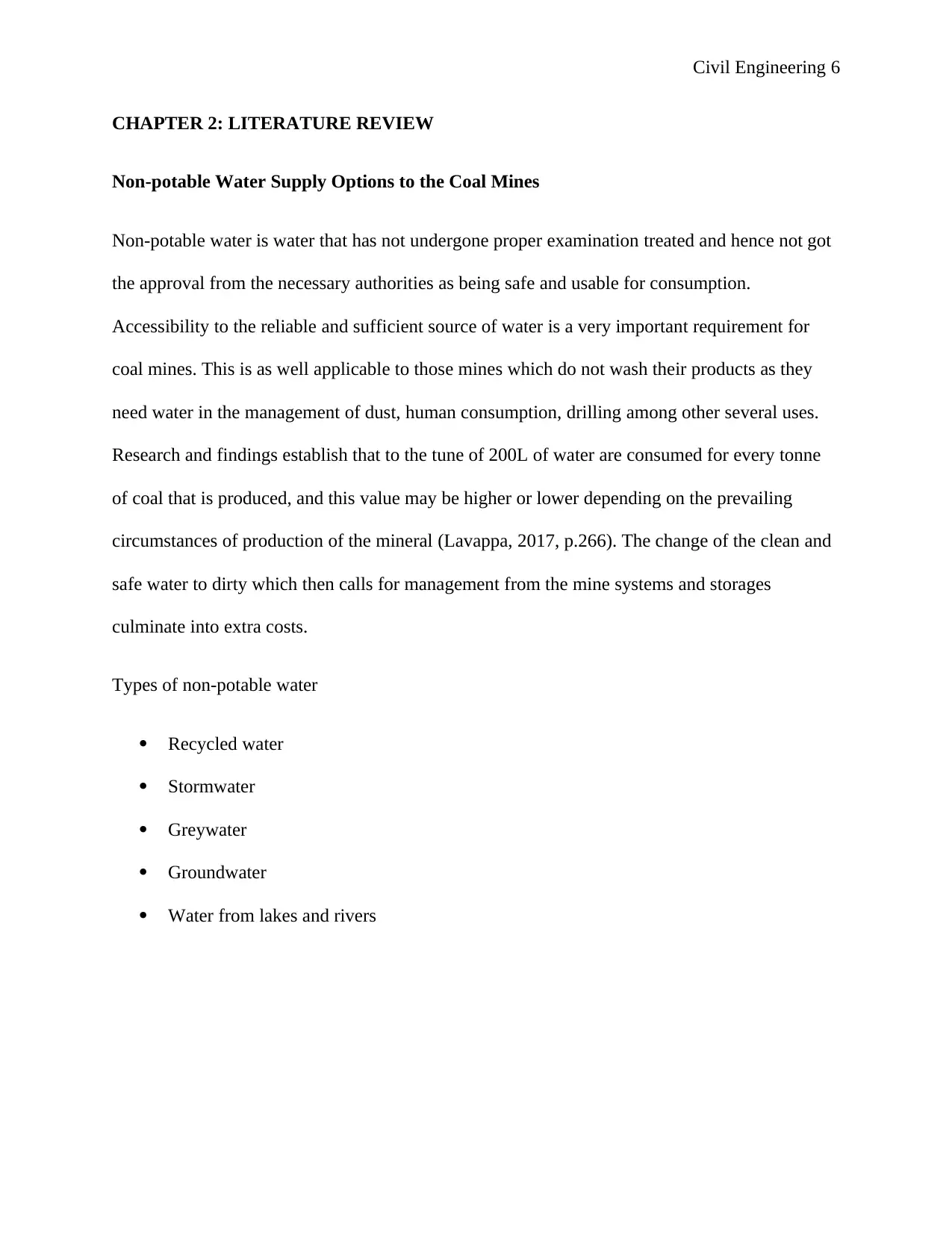
Civil Engineering 6
CHAPTER 2: LITERATURE REVIEW
Non-potable Water Supply Options to the Coal Mines
Non-potable water is water that has not undergone proper examination treated and hence not got
the approval from the necessary authorities as being safe and usable for consumption.
Accessibility to the reliable and sufficient source of water is a very important requirement for
coal mines. This is as well applicable to those mines which do not wash their products as they
need water in the management of dust, human consumption, drilling among other several uses.
Research and findings establish that to the tune of 200L of water are consumed for every tonne
of coal that is produced, and this value may be higher or lower depending on the prevailing
circumstances of production of the mineral (Lavappa, 2017, p.266). The change of the clean and
safe water to dirty which then calls for management from the mine systems and storages
culminate into extra costs.
Types of non-potable water
Recycled water
Stormwater
Greywater
Groundwater
Water from lakes and rivers
CHAPTER 2: LITERATURE REVIEW
Non-potable Water Supply Options to the Coal Mines
Non-potable water is water that has not undergone proper examination treated and hence not got
the approval from the necessary authorities as being safe and usable for consumption.
Accessibility to the reliable and sufficient source of water is a very important requirement for
coal mines. This is as well applicable to those mines which do not wash their products as they
need water in the management of dust, human consumption, drilling among other several uses.
Research and findings establish that to the tune of 200L of water are consumed for every tonne
of coal that is produced, and this value may be higher or lower depending on the prevailing
circumstances of production of the mineral (Lavappa, 2017, p.266). The change of the clean and
safe water to dirty which then calls for management from the mine systems and storages
culminate into extra costs.
Types of non-potable water
Recycled water
Stormwater
Greywater
Groundwater
Water from lakes and rivers
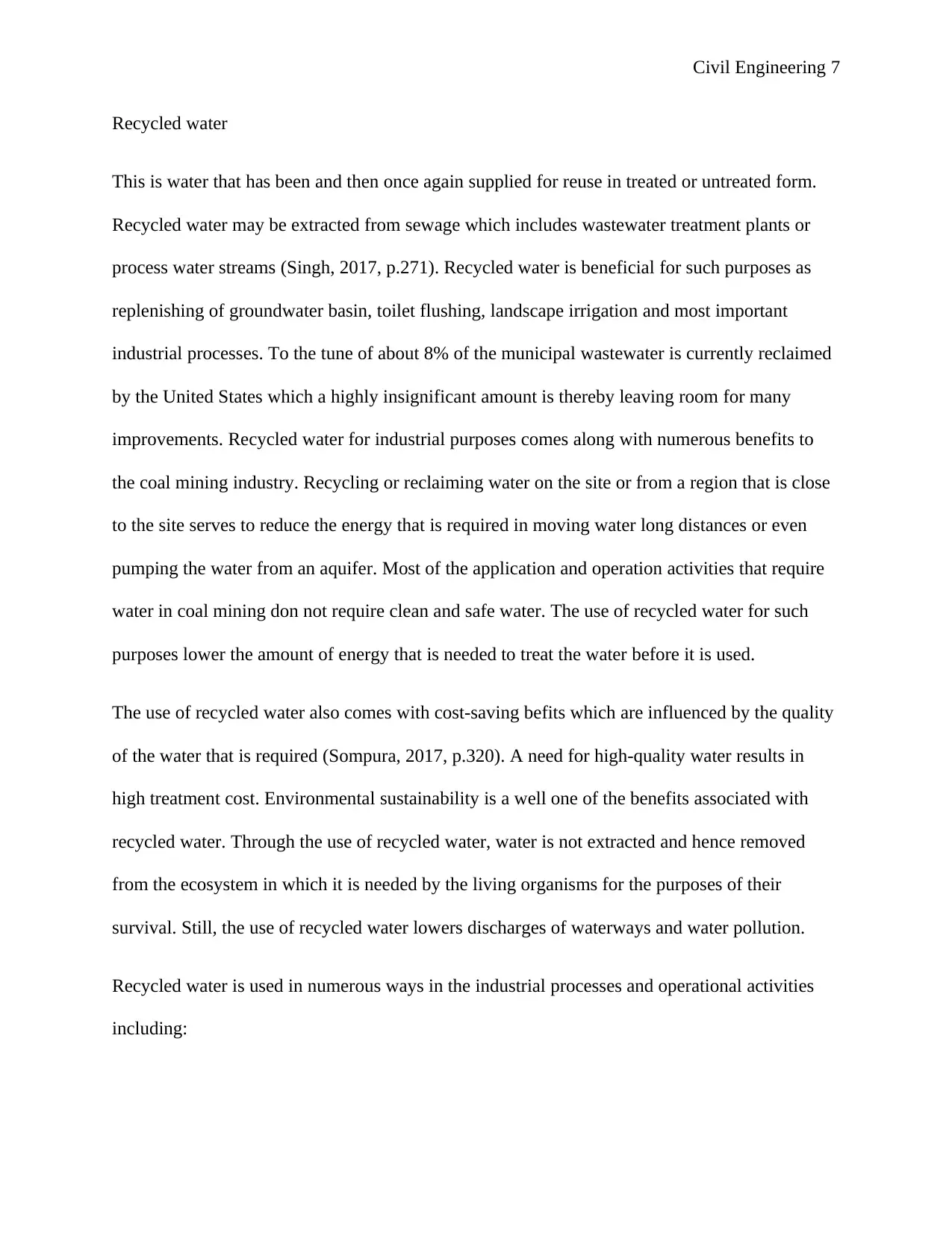
Civil Engineering 7
Recycled water
This is water that has been and then once again supplied for reuse in treated or untreated form.
Recycled water may be extracted from sewage which includes wastewater treatment plants or
process water streams (Singh, 2017, p.271). Recycled water is beneficial for such purposes as
replenishing of groundwater basin, toilet flushing, landscape irrigation and most important
industrial processes. To the tune of about 8% of the municipal wastewater is currently reclaimed
by the United States which a highly insignificant amount is thereby leaving room for many
improvements. Recycled water for industrial purposes comes along with numerous benefits to
the coal mining industry. Recycling or reclaiming water on the site or from a region that is close
to the site serves to reduce the energy that is required in moving water long distances or even
pumping the water from an aquifer. Most of the application and operation activities that require
water in coal mining don not require clean and safe water. The use of recycled water for such
purposes lower the amount of energy that is needed to treat the water before it is used.
The use of recycled water also comes with cost-saving befits which are influenced by the quality
of the water that is required (Sompura, 2017, p.320). A need for high-quality water results in
high treatment cost. Environmental sustainability is a well one of the benefits associated with
recycled water. Through the use of recycled water, water is not extracted and hence removed
from the ecosystem in which it is needed by the living organisms for the purposes of their
survival. Still, the use of recycled water lowers discharges of waterways and water pollution.
Recycled water is used in numerous ways in the industrial processes and operational activities
including:
Recycled water
This is water that has been and then once again supplied for reuse in treated or untreated form.
Recycled water may be extracted from sewage which includes wastewater treatment plants or
process water streams (Singh, 2017, p.271). Recycled water is beneficial for such purposes as
replenishing of groundwater basin, toilet flushing, landscape irrigation and most important
industrial processes. To the tune of about 8% of the municipal wastewater is currently reclaimed
by the United States which a highly insignificant amount is thereby leaving room for many
improvements. Recycled water for industrial purposes comes along with numerous benefits to
the coal mining industry. Recycling or reclaiming water on the site or from a region that is close
to the site serves to reduce the energy that is required in moving water long distances or even
pumping the water from an aquifer. Most of the application and operation activities that require
water in coal mining don not require clean and safe water. The use of recycled water for such
purposes lower the amount of energy that is needed to treat the water before it is used.
The use of recycled water also comes with cost-saving befits which are influenced by the quality
of the water that is required (Sompura, 2017, p.320). A need for high-quality water results in
high treatment cost. Environmental sustainability is a well one of the benefits associated with
recycled water. Through the use of recycled water, water is not extracted and hence removed
from the ecosystem in which it is needed by the living organisms for the purposes of their
survival. Still, the use of recycled water lowers discharges of waterways and water pollution.
Recycled water is used in numerous ways in the industrial processes and operational activities
including:
Paraphrase This Document
Need a fresh take? Get an instant paraphrase of this document with our AI Paraphraser
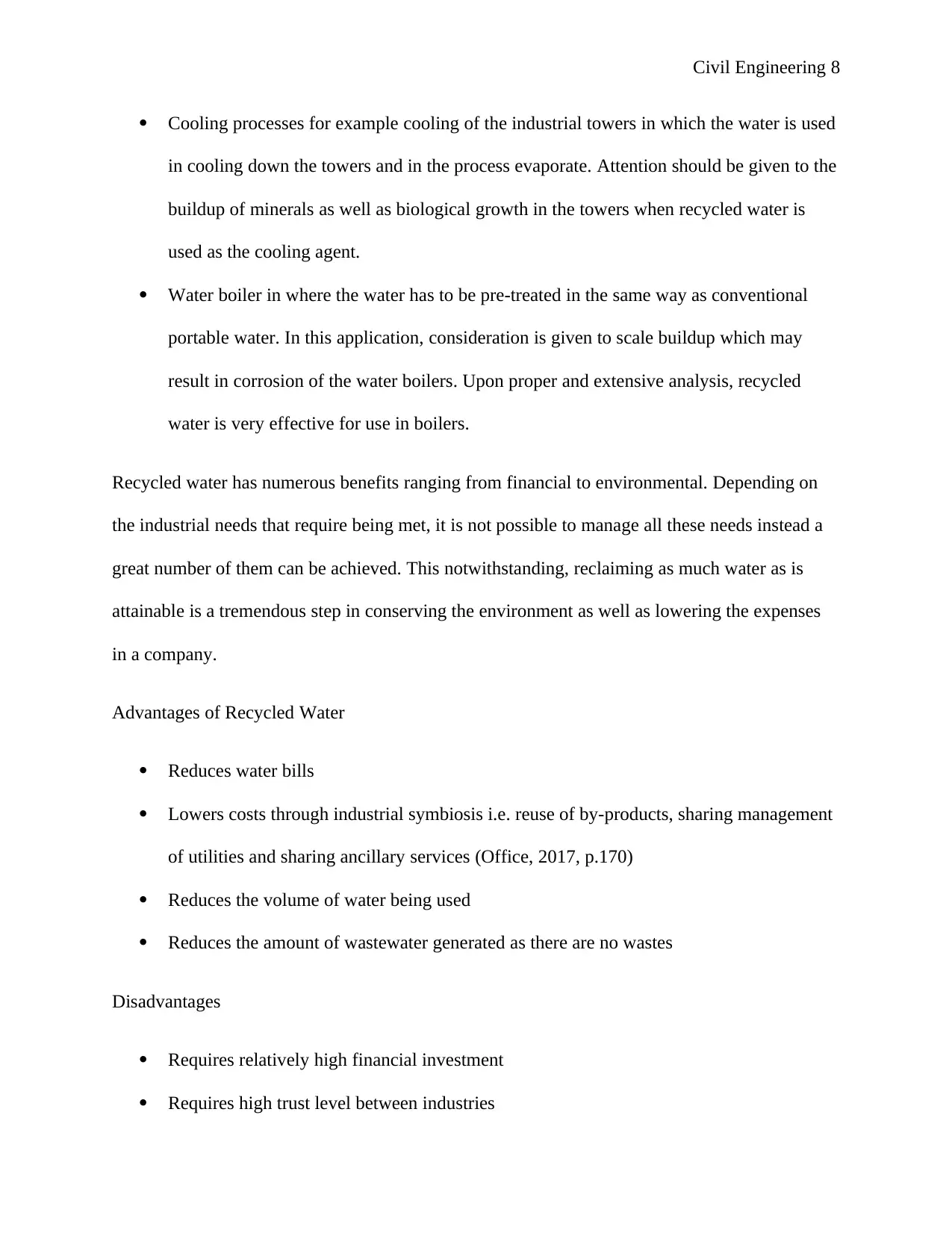
Civil Engineering 8
Cooling processes for example cooling of the industrial towers in which the water is used
in cooling down the towers and in the process evaporate. Attention should be given to the
buildup of minerals as well as biological growth in the towers when recycled water is
used as the cooling agent.
Water boiler in where the water has to be pre-treated in the same way as conventional
portable water. In this application, consideration is given to scale buildup which may
result in corrosion of the water boilers. Upon proper and extensive analysis, recycled
water is very effective for use in boilers.
Recycled water has numerous benefits ranging from financial to environmental. Depending on
the industrial needs that require being met, it is not possible to manage all these needs instead a
great number of them can be achieved. This notwithstanding, reclaiming as much water as is
attainable is a tremendous step in conserving the environment as well as lowering the expenses
in a company.
Advantages of Recycled Water
Reduces water bills
Lowers costs through industrial symbiosis i.e. reuse of by-products, sharing management
of utilities and sharing ancillary services (Office, 2017, p.170)
Reduces the volume of water being used
Reduces the amount of wastewater generated as there are no wastes
Disadvantages
Requires relatively high financial investment
Requires high trust level between industries
Cooling processes for example cooling of the industrial towers in which the water is used
in cooling down the towers and in the process evaporate. Attention should be given to the
buildup of minerals as well as biological growth in the towers when recycled water is
used as the cooling agent.
Water boiler in where the water has to be pre-treated in the same way as conventional
portable water. In this application, consideration is given to scale buildup which may
result in corrosion of the water boilers. Upon proper and extensive analysis, recycled
water is very effective for use in boilers.
Recycled water has numerous benefits ranging from financial to environmental. Depending on
the industrial needs that require being met, it is not possible to manage all these needs instead a
great number of them can be achieved. This notwithstanding, reclaiming as much water as is
attainable is a tremendous step in conserving the environment as well as lowering the expenses
in a company.
Advantages of Recycled Water
Reduces water bills
Lowers costs through industrial symbiosis i.e. reuse of by-products, sharing management
of utilities and sharing ancillary services (Office, 2017, p.170)
Reduces the volume of water being used
Reduces the amount of wastewater generated as there are no wastes
Disadvantages
Requires relatively high financial investment
Requires high trust level between industries
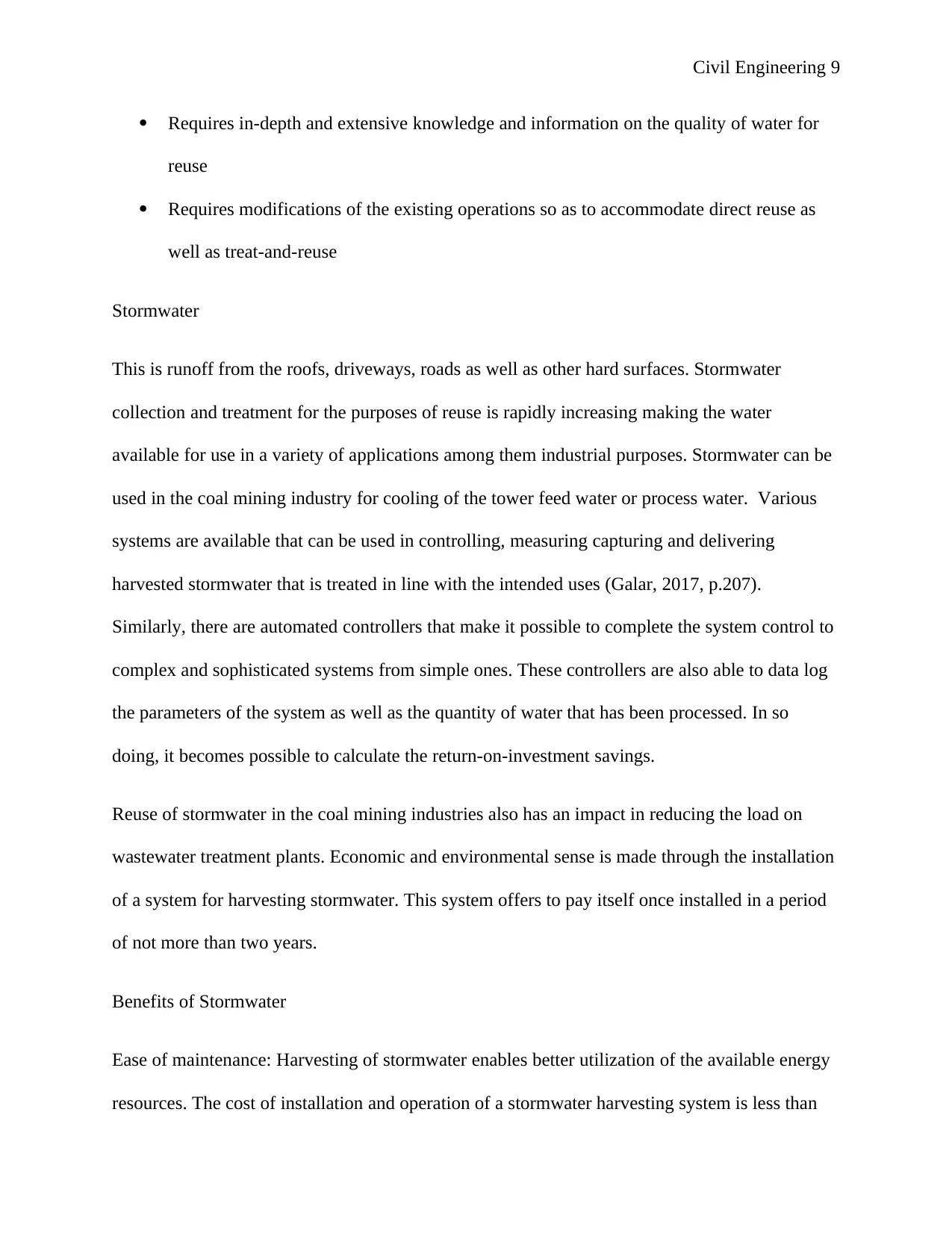
Civil Engineering 9
Requires in-depth and extensive knowledge and information on the quality of water for
reuse
Requires modifications of the existing operations so as to accommodate direct reuse as
well as treat-and-reuse
Stormwater
This is runoff from the roofs, driveways, roads as well as other hard surfaces. Stormwater
collection and treatment for the purposes of reuse is rapidly increasing making the water
available for use in a variety of applications among them industrial purposes. Stormwater can be
used in the coal mining industry for cooling of the tower feed water or process water. Various
systems are available that can be used in controlling, measuring capturing and delivering
harvested stormwater that is treated in line with the intended uses (Galar, 2017, p.207).
Similarly, there are automated controllers that make it possible to complete the system control to
complex and sophisticated systems from simple ones. These controllers are also able to data log
the parameters of the system as well as the quantity of water that has been processed. In so
doing, it becomes possible to calculate the return-on-investment savings.
Reuse of stormwater in the coal mining industries also has an impact in reducing the load on
wastewater treatment plants. Economic and environmental sense is made through the installation
of a system for harvesting stormwater. This system offers to pay itself once installed in a period
of not more than two years.
Benefits of Stormwater
Ease of maintenance: Harvesting of stormwater enables better utilization of the available energy
resources. The cost of installation and operation of a stormwater harvesting system is less than
Requires in-depth and extensive knowledge and information on the quality of water for
reuse
Requires modifications of the existing operations so as to accommodate direct reuse as
well as treat-and-reuse
Stormwater
This is runoff from the roofs, driveways, roads as well as other hard surfaces. Stormwater
collection and treatment for the purposes of reuse is rapidly increasing making the water
available for use in a variety of applications among them industrial purposes. Stormwater can be
used in the coal mining industry for cooling of the tower feed water or process water. Various
systems are available that can be used in controlling, measuring capturing and delivering
harvested stormwater that is treated in line with the intended uses (Galar, 2017, p.207).
Similarly, there are automated controllers that make it possible to complete the system control to
complex and sophisticated systems from simple ones. These controllers are also able to data log
the parameters of the system as well as the quantity of water that has been processed. In so
doing, it becomes possible to calculate the return-on-investment savings.
Reuse of stormwater in the coal mining industries also has an impact in reducing the load on
wastewater treatment plants. Economic and environmental sense is made through the installation
of a system for harvesting stormwater. This system offers to pay itself once installed in a period
of not more than two years.
Benefits of Stormwater
Ease of maintenance: Harvesting of stormwater enables better utilization of the available energy
resources. The cost of installation and operation of a stormwater harvesting system is less than
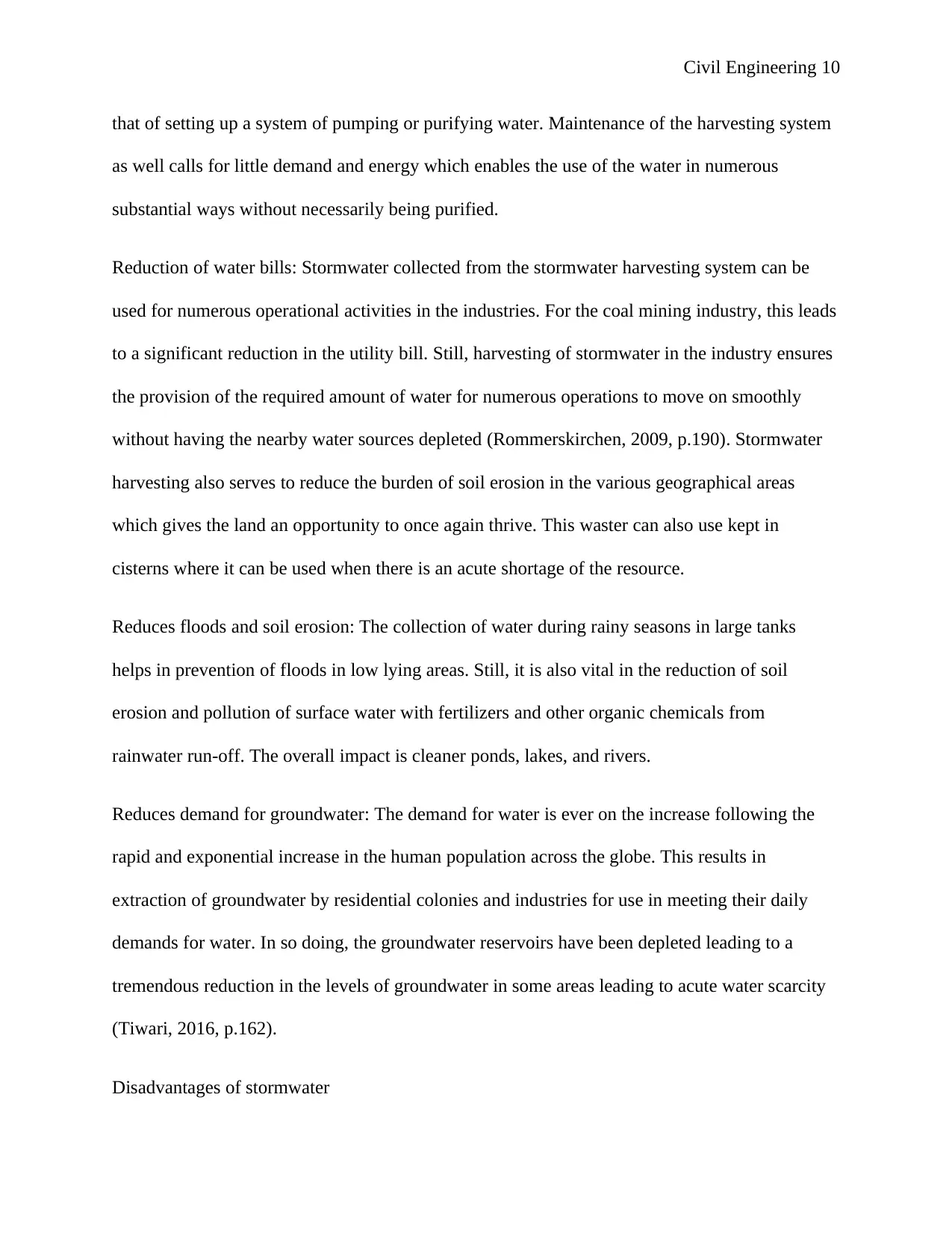
Civil Engineering 10
that of setting up a system of pumping or purifying water. Maintenance of the harvesting system
as well calls for little demand and energy which enables the use of the water in numerous
substantial ways without necessarily being purified.
Reduction of water bills: Stormwater collected from the stormwater harvesting system can be
used for numerous operational activities in the industries. For the coal mining industry, this leads
to a significant reduction in the utility bill. Still, harvesting of stormwater in the industry ensures
the provision of the required amount of water for numerous operations to move on smoothly
without having the nearby water sources depleted (Rommerskirchen, 2009, p.190). Stormwater
harvesting also serves to reduce the burden of soil erosion in the various geographical areas
which gives the land an opportunity to once again thrive. This waster can also use kept in
cisterns where it can be used when there is an acute shortage of the resource.
Reduces floods and soil erosion: The collection of water during rainy seasons in large tanks
helps in prevention of floods in low lying areas. Still, it is also vital in the reduction of soil
erosion and pollution of surface water with fertilizers and other organic chemicals from
rainwater run-off. The overall impact is cleaner ponds, lakes, and rivers.
Reduces demand for groundwater: The demand for water is ever on the increase following the
rapid and exponential increase in the human population across the globe. This results in
extraction of groundwater by residential colonies and industries for use in meeting their daily
demands for water. In so doing, the groundwater reservoirs have been depleted leading to a
tremendous reduction in the levels of groundwater in some areas leading to acute water scarcity
(Tiwari, 2016, p.162).
Disadvantages of stormwater
that of setting up a system of pumping or purifying water. Maintenance of the harvesting system
as well calls for little demand and energy which enables the use of the water in numerous
substantial ways without necessarily being purified.
Reduction of water bills: Stormwater collected from the stormwater harvesting system can be
used for numerous operational activities in the industries. For the coal mining industry, this leads
to a significant reduction in the utility bill. Still, harvesting of stormwater in the industry ensures
the provision of the required amount of water for numerous operations to move on smoothly
without having the nearby water sources depleted (Rommerskirchen, 2009, p.190). Stormwater
harvesting also serves to reduce the burden of soil erosion in the various geographical areas
which gives the land an opportunity to once again thrive. This waster can also use kept in
cisterns where it can be used when there is an acute shortage of the resource.
Reduces floods and soil erosion: The collection of water during rainy seasons in large tanks
helps in prevention of floods in low lying areas. Still, it is also vital in the reduction of soil
erosion and pollution of surface water with fertilizers and other organic chemicals from
rainwater run-off. The overall impact is cleaner ponds, lakes, and rivers.
Reduces demand for groundwater: The demand for water is ever on the increase following the
rapid and exponential increase in the human population across the globe. This results in
extraction of groundwater by residential colonies and industries for use in meeting their daily
demands for water. In so doing, the groundwater reservoirs have been depleted leading to a
tremendous reduction in the levels of groundwater in some areas leading to acute water scarcity
(Tiwari, 2016, p.162).
Disadvantages of stormwater
Secure Best Marks with AI Grader
Need help grading? Try our AI Grader for instant feedback on your assignments.
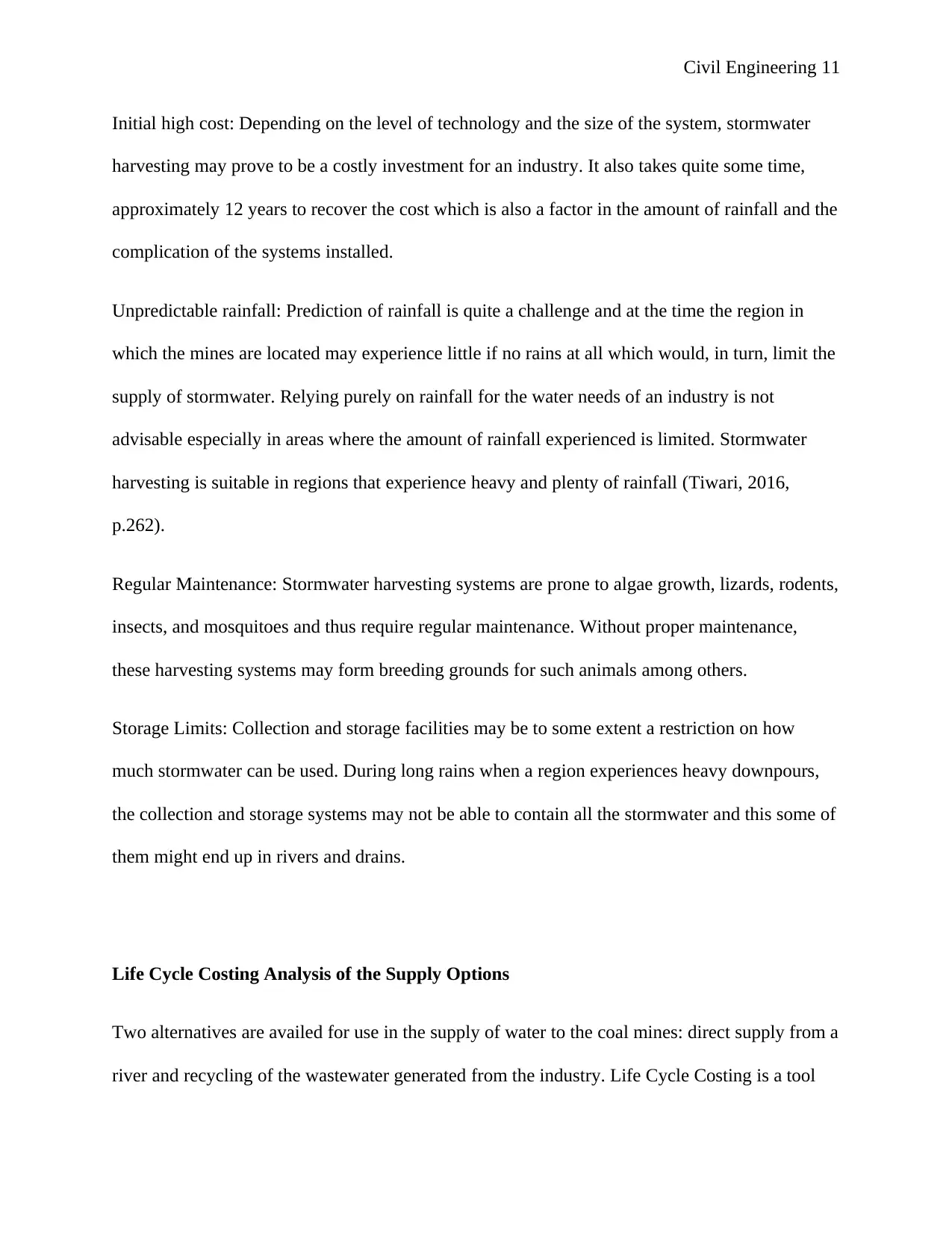
Civil Engineering 11
Initial high cost: Depending on the level of technology and the size of the system, stormwater
harvesting may prove to be a costly investment for an industry. It also takes quite some time,
approximately 12 years to recover the cost which is also a factor in the amount of rainfall and the
complication of the systems installed.
Unpredictable rainfall: Prediction of rainfall is quite a challenge and at the time the region in
which the mines are located may experience little if no rains at all which would, in turn, limit the
supply of stormwater. Relying purely on rainfall for the water needs of an industry is not
advisable especially in areas where the amount of rainfall experienced is limited. Stormwater
harvesting is suitable in regions that experience heavy and plenty of rainfall (Tiwari, 2016,
p.262).
Regular Maintenance: Stormwater harvesting systems are prone to algae growth, lizards, rodents,
insects, and mosquitoes and thus require regular maintenance. Without proper maintenance,
these harvesting systems may form breeding grounds for such animals among others.
Storage Limits: Collection and storage facilities may be to some extent a restriction on how
much stormwater can be used. During long rains when a region experiences heavy downpours,
the collection and storage systems may not be able to contain all the stormwater and this some of
them might end up in rivers and drains.
Life Cycle Costing Analysis of the Supply Options
Two alternatives are availed for use in the supply of water to the coal mines: direct supply from a
river and recycling of the wastewater generated from the industry. Life Cycle Costing is a tool
Initial high cost: Depending on the level of technology and the size of the system, stormwater
harvesting may prove to be a costly investment for an industry. It also takes quite some time,
approximately 12 years to recover the cost which is also a factor in the amount of rainfall and the
complication of the systems installed.
Unpredictable rainfall: Prediction of rainfall is quite a challenge and at the time the region in
which the mines are located may experience little if no rains at all which would, in turn, limit the
supply of stormwater. Relying purely on rainfall for the water needs of an industry is not
advisable especially in areas where the amount of rainfall experienced is limited. Stormwater
harvesting is suitable in regions that experience heavy and plenty of rainfall (Tiwari, 2016,
p.262).
Regular Maintenance: Stormwater harvesting systems are prone to algae growth, lizards, rodents,
insects, and mosquitoes and thus require regular maintenance. Without proper maintenance,
these harvesting systems may form breeding grounds for such animals among others.
Storage Limits: Collection and storage facilities may be to some extent a restriction on how
much stormwater can be used. During long rains when a region experiences heavy downpours,
the collection and storage systems may not be able to contain all the stormwater and this some of
them might end up in rivers and drains.
Life Cycle Costing Analysis of the Supply Options
Two alternatives are availed for use in the supply of water to the coal mines: direct supply from a
river and recycling of the wastewater generated from the industry. Life Cycle Costing is a tool
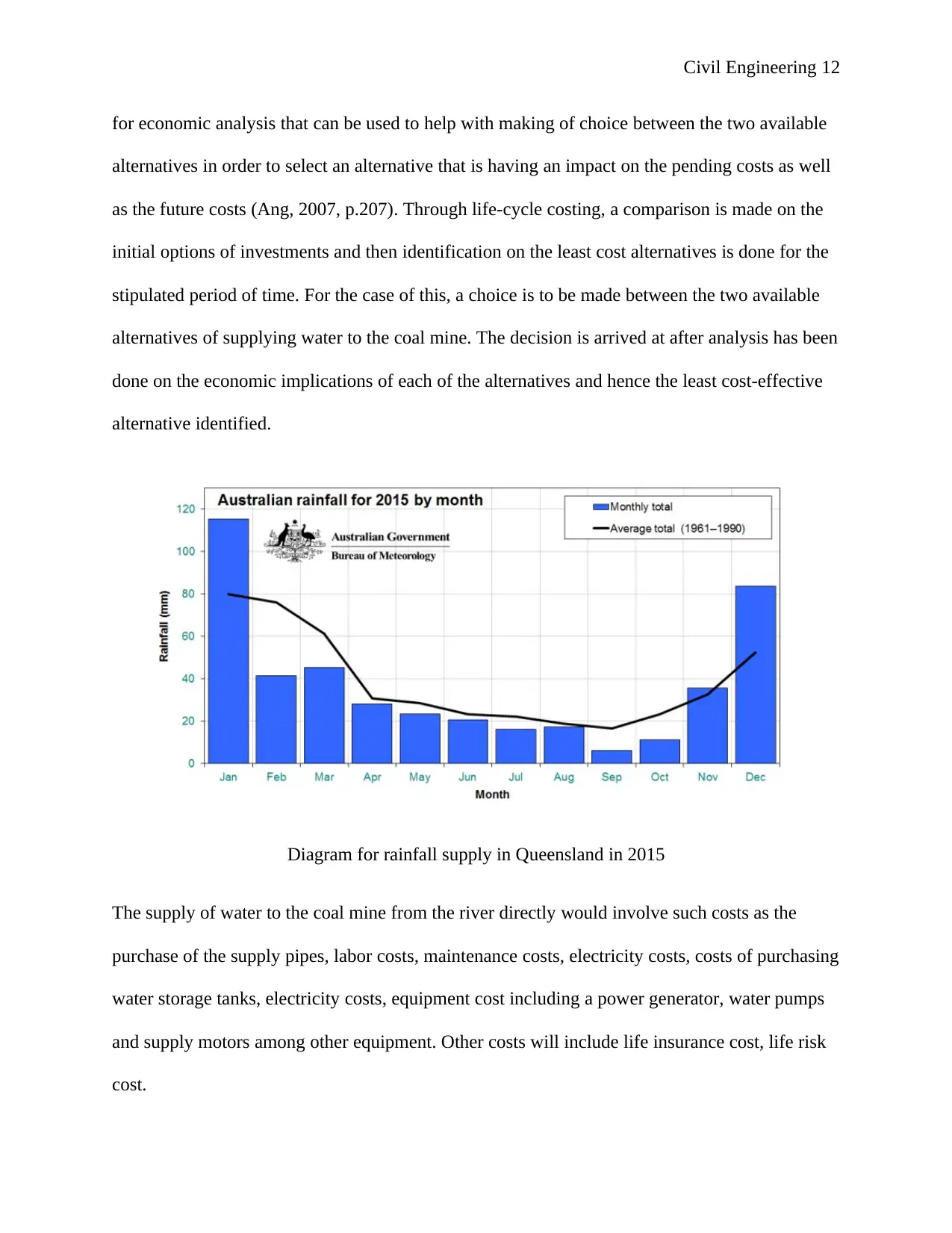
Civil Engineering 12
for economic analysis that can be used to help with making of choice between the two available
alternatives in order to select an alternative that is having an impact on the pending costs as well
as the future costs (Ang, 2007, p.207). Through life-cycle costing, a comparison is made on the
initial options of investments and then identification on the least cost alternatives is done for the
stipulated period of time. For the case of this, a choice is to be made between the two available
alternatives of supplying water to the coal mine. The decision is arrived at after analysis has been
done on the economic implications of each of the alternatives and hence the least cost-effective
alternative identified.
Diagram for rainfall supply in Queensland in 2015
The supply of water to the coal mine from the river directly would involve such costs as the
purchase of the supply pipes, labor costs, maintenance costs, electricity costs, costs of purchasing
water storage tanks, electricity costs, equipment cost including a power generator, water pumps
and supply motors among other equipment. Other costs will include life insurance cost, life risk
cost.
for economic analysis that can be used to help with making of choice between the two available
alternatives in order to select an alternative that is having an impact on the pending costs as well
as the future costs (Ang, 2007, p.207). Through life-cycle costing, a comparison is made on the
initial options of investments and then identification on the least cost alternatives is done for the
stipulated period of time. For the case of this, a choice is to be made between the two available
alternatives of supplying water to the coal mine. The decision is arrived at after analysis has been
done on the economic implications of each of the alternatives and hence the least cost-effective
alternative identified.
Diagram for rainfall supply in Queensland in 2015
The supply of water to the coal mine from the river directly would involve such costs as the
purchase of the supply pipes, labor costs, maintenance costs, electricity costs, costs of purchasing
water storage tanks, electricity costs, equipment cost including a power generator, water pumps
and supply motors among other equipment. Other costs will include life insurance cost, life risk
cost.
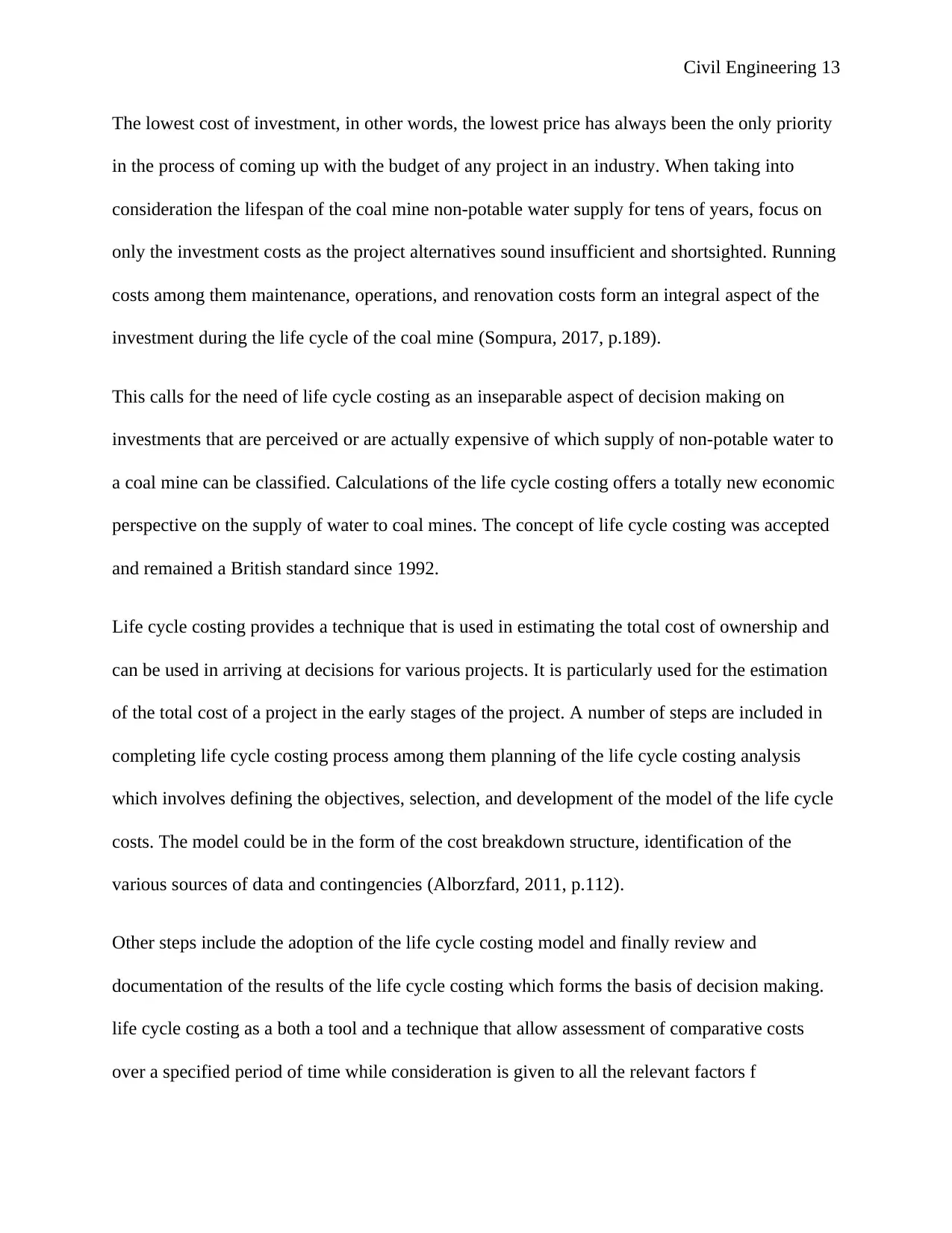
Civil Engineering 13
The lowest cost of investment, in other words, the lowest price has always been the only priority
in the process of coming up with the budget of any project in an industry. When taking into
consideration the lifespan of the coal mine non-potable water supply for tens of years, focus on
only the investment costs as the project alternatives sound insufficient and shortsighted. Running
costs among them maintenance, operations, and renovation costs form an integral aspect of the
investment during the life cycle of the coal mine (Sompura, 2017, p.189).
This calls for the need of life cycle costing as an inseparable aspect of decision making on
investments that are perceived or are actually expensive of which supply of non-potable water to
a coal mine can be classified. Calculations of the life cycle costing offers a totally new economic
perspective on the supply of water to coal mines. The concept of life cycle costing was accepted
and remained a British standard since 1992.
Life cycle costing provides a technique that is used in estimating the total cost of ownership and
can be used in arriving at decisions for various projects. It is particularly used for the estimation
of the total cost of a project in the early stages of the project. A number of steps are included in
completing life cycle costing process among them planning of the life cycle costing analysis
which involves defining the objectives, selection, and development of the model of the life cycle
costs. The model could be in the form of the cost breakdown structure, identification of the
various sources of data and contingencies (Alborzfard, 2011, p.112).
Other steps include the adoption of the life cycle costing model and finally review and
documentation of the results of the life cycle costing which forms the basis of decision making.
life cycle costing as a both a tool and a technique that allow assessment of comparative costs
over a specified period of time while consideration is given to all the relevant factors f
The lowest cost of investment, in other words, the lowest price has always been the only priority
in the process of coming up with the budget of any project in an industry. When taking into
consideration the lifespan of the coal mine non-potable water supply for tens of years, focus on
only the investment costs as the project alternatives sound insufficient and shortsighted. Running
costs among them maintenance, operations, and renovation costs form an integral aspect of the
investment during the life cycle of the coal mine (Sompura, 2017, p.189).
This calls for the need of life cycle costing as an inseparable aspect of decision making on
investments that are perceived or are actually expensive of which supply of non-potable water to
a coal mine can be classified. Calculations of the life cycle costing offers a totally new economic
perspective on the supply of water to coal mines. The concept of life cycle costing was accepted
and remained a British standard since 1992.
Life cycle costing provides a technique that is used in estimating the total cost of ownership and
can be used in arriving at decisions for various projects. It is particularly used for the estimation
of the total cost of a project in the early stages of the project. A number of steps are included in
completing life cycle costing process among them planning of the life cycle costing analysis
which involves defining the objectives, selection, and development of the model of the life cycle
costs. The model could be in the form of the cost breakdown structure, identification of the
various sources of data and contingencies (Alborzfard, 2011, p.112).
Other steps include the adoption of the life cycle costing model and finally review and
documentation of the results of the life cycle costing which forms the basis of decision making.
life cycle costing as a both a tool and a technique that allow assessment of comparative costs
over a specified period of time while consideration is given to all the relevant factors f
Paraphrase This Document
Need a fresh take? Get an instant paraphrase of this document with our AI Paraphraser
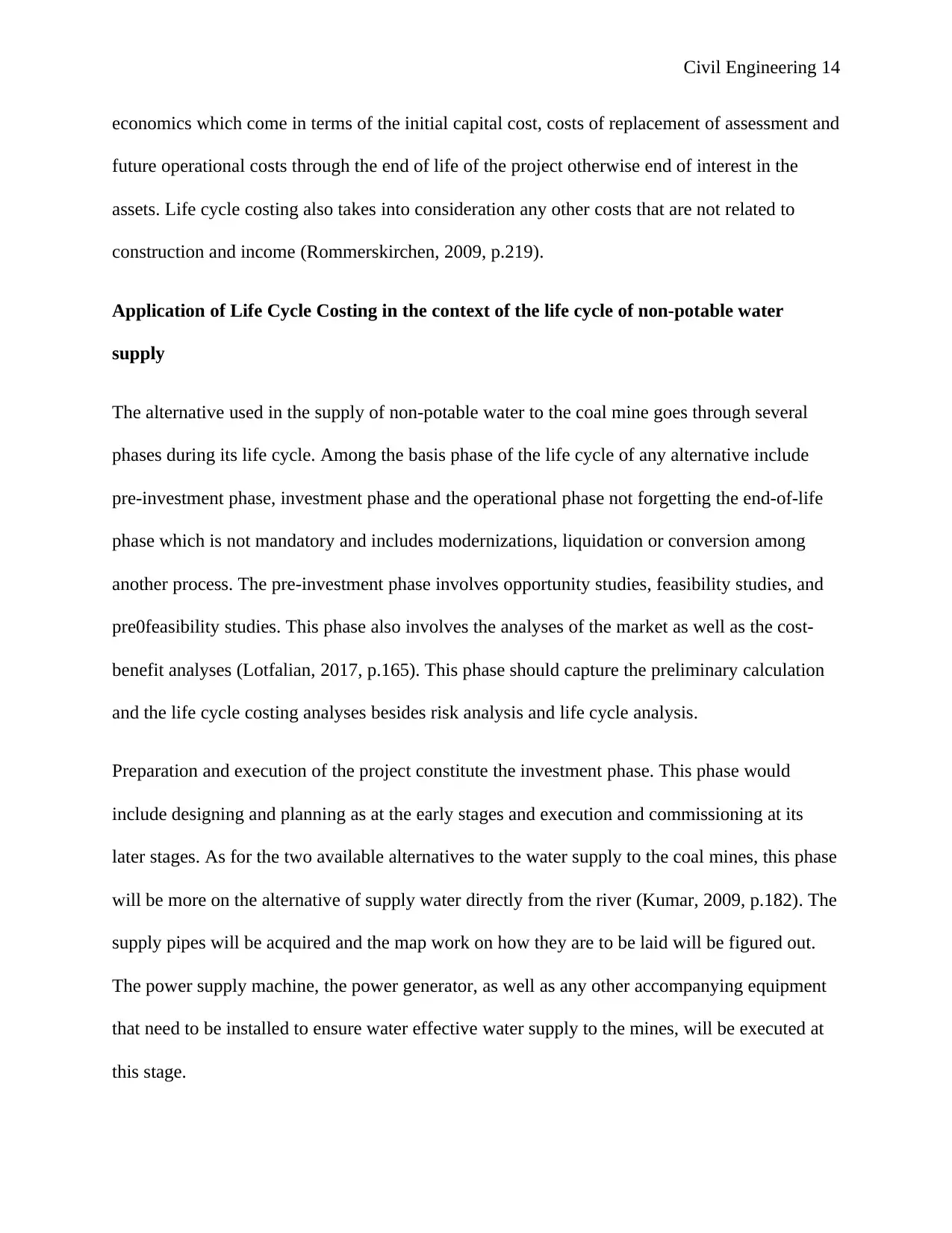
Civil Engineering 14
economics which come in terms of the initial capital cost, costs of replacement of assessment and
future operational costs through the end of life of the project otherwise end of interest in the
assets. Life cycle costing also takes into consideration any other costs that are not related to
construction and income (Rommerskirchen, 2009, p.219).
Application of Life Cycle Costing in the context of the life cycle of non-potable water
supply
The alternative used in the supply of non-potable water to the coal mine goes through several
phases during its life cycle. Among the basis phase of the life cycle of any alternative include
pre-investment phase, investment phase and the operational phase not forgetting the end-of-life
phase which is not mandatory and includes modernizations, liquidation or conversion among
another process. The pre-investment phase involves opportunity studies, feasibility studies, and
pre0feasibility studies. This phase also involves the analyses of the market as well as the cost-
benefit analyses (Lotfalian, 2017, p.165). This phase should capture the preliminary calculation
and the life cycle costing analyses besides risk analysis and life cycle analysis.
Preparation and execution of the project constitute the investment phase. This phase would
include designing and planning as at the early stages and execution and commissioning at its
later stages. As for the two available alternatives to the water supply to the coal mines, this phase
will be more on the alternative of supply water directly from the river (Kumar, 2009, p.182). The
supply pipes will be acquired and the map work on how they are to be laid will be figured out.
The power supply machine, the power generator, as well as any other accompanying equipment
that need to be installed to ensure water effective water supply to the mines, will be executed at
this stage.
economics which come in terms of the initial capital cost, costs of replacement of assessment and
future operational costs through the end of life of the project otherwise end of interest in the
assets. Life cycle costing also takes into consideration any other costs that are not related to
construction and income (Rommerskirchen, 2009, p.219).
Application of Life Cycle Costing in the context of the life cycle of non-potable water
supply
The alternative used in the supply of non-potable water to the coal mine goes through several
phases during its life cycle. Among the basis phase of the life cycle of any alternative include
pre-investment phase, investment phase and the operational phase not forgetting the end-of-life
phase which is not mandatory and includes modernizations, liquidation or conversion among
another process. The pre-investment phase involves opportunity studies, feasibility studies, and
pre0feasibility studies. This phase also involves the analyses of the market as well as the cost-
benefit analyses (Lotfalian, 2017, p.165). This phase should capture the preliminary calculation
and the life cycle costing analyses besides risk analysis and life cycle analysis.
Preparation and execution of the project constitute the investment phase. This phase would
include designing and planning as at the early stages and execution and commissioning at its
later stages. As for the two available alternatives to the water supply to the coal mines, this phase
will be more on the alternative of supply water directly from the river (Kumar, 2009, p.182). The
supply pipes will be acquired and the map work on how they are to be laid will be figured out.
The power supply machine, the power generator, as well as any other accompanying equipment
that need to be installed to ensure water effective water supply to the mines, will be executed at
this stage.
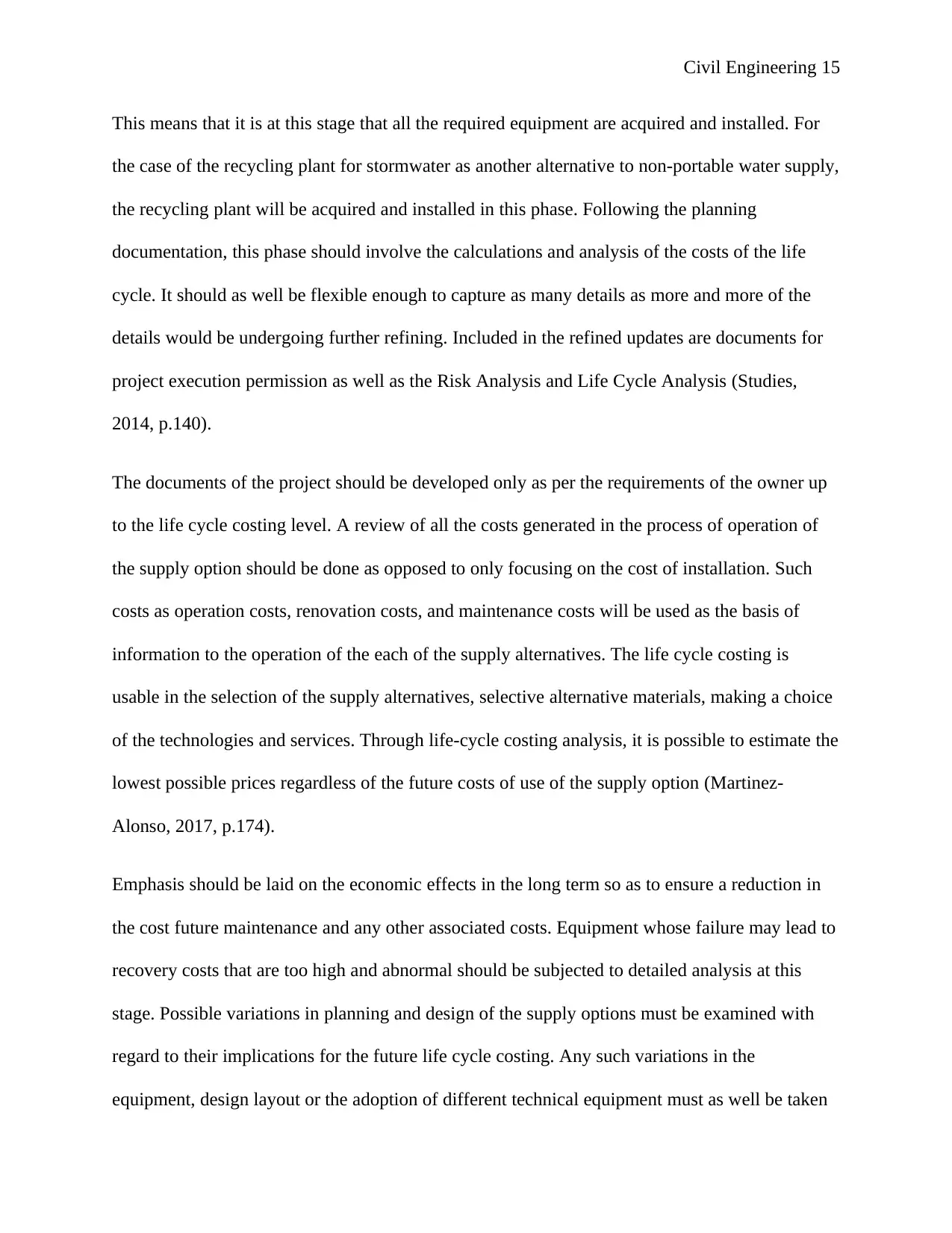
Civil Engineering 15
This means that it is at this stage that all the required equipment are acquired and installed. For
the case of the recycling plant for stormwater as another alternative to non-portable water supply,
the recycling plant will be acquired and installed in this phase. Following the planning
documentation, this phase should involve the calculations and analysis of the costs of the life
cycle. It should as well be flexible enough to capture as many details as more and more of the
details would be undergoing further refining. Included in the refined updates are documents for
project execution permission as well as the Risk Analysis and Life Cycle Analysis (Studies,
2014, p.140).
The documents of the project should be developed only as per the requirements of the owner up
to the life cycle costing level. A review of all the costs generated in the process of operation of
the supply option should be done as opposed to only focusing on the cost of installation. Such
costs as operation costs, renovation costs, and maintenance costs will be used as the basis of
information to the operation of the each of the supply alternatives. The life cycle costing is
usable in the selection of the supply alternatives, selective alternative materials, making a choice
of the technologies and services. Through life-cycle costing analysis, it is possible to estimate the
lowest possible prices regardless of the future costs of use of the supply option (Martinez-
Alonso, 2017, p.174).
Emphasis should be laid on the economic effects in the long term so as to ensure a reduction in
the cost future maintenance and any other associated costs. Equipment whose failure may lead to
recovery costs that are too high and abnormal should be subjected to detailed analysis at this
stage. Possible variations in planning and design of the supply options must be examined with
regard to their implications for the future life cycle costing. Any such variations in the
equipment, design layout or the adoption of different technical equipment must as well be taken
This means that it is at this stage that all the required equipment are acquired and installed. For
the case of the recycling plant for stormwater as another alternative to non-portable water supply,
the recycling plant will be acquired and installed in this phase. Following the planning
documentation, this phase should involve the calculations and analysis of the costs of the life
cycle. It should as well be flexible enough to capture as many details as more and more of the
details would be undergoing further refining. Included in the refined updates are documents for
project execution permission as well as the Risk Analysis and Life Cycle Analysis (Studies,
2014, p.140).
The documents of the project should be developed only as per the requirements of the owner up
to the life cycle costing level. A review of all the costs generated in the process of operation of
the supply option should be done as opposed to only focusing on the cost of installation. Such
costs as operation costs, renovation costs, and maintenance costs will be used as the basis of
information to the operation of the each of the supply alternatives. The life cycle costing is
usable in the selection of the supply alternatives, selective alternative materials, making a choice
of the technologies and services. Through life-cycle costing analysis, it is possible to estimate the
lowest possible prices regardless of the future costs of use of the supply option (Martinez-
Alonso, 2017, p.174).
Emphasis should be laid on the economic effects in the long term so as to ensure a reduction in
the cost future maintenance and any other associated costs. Equipment whose failure may lead to
recovery costs that are too high and abnormal should be subjected to detailed analysis at this
stage. Possible variations in planning and design of the supply options must be examined with
regard to their implications for the future life cycle costing. Any such variations in the
equipment, design layout or the adoption of different technical equipment must as well be taken
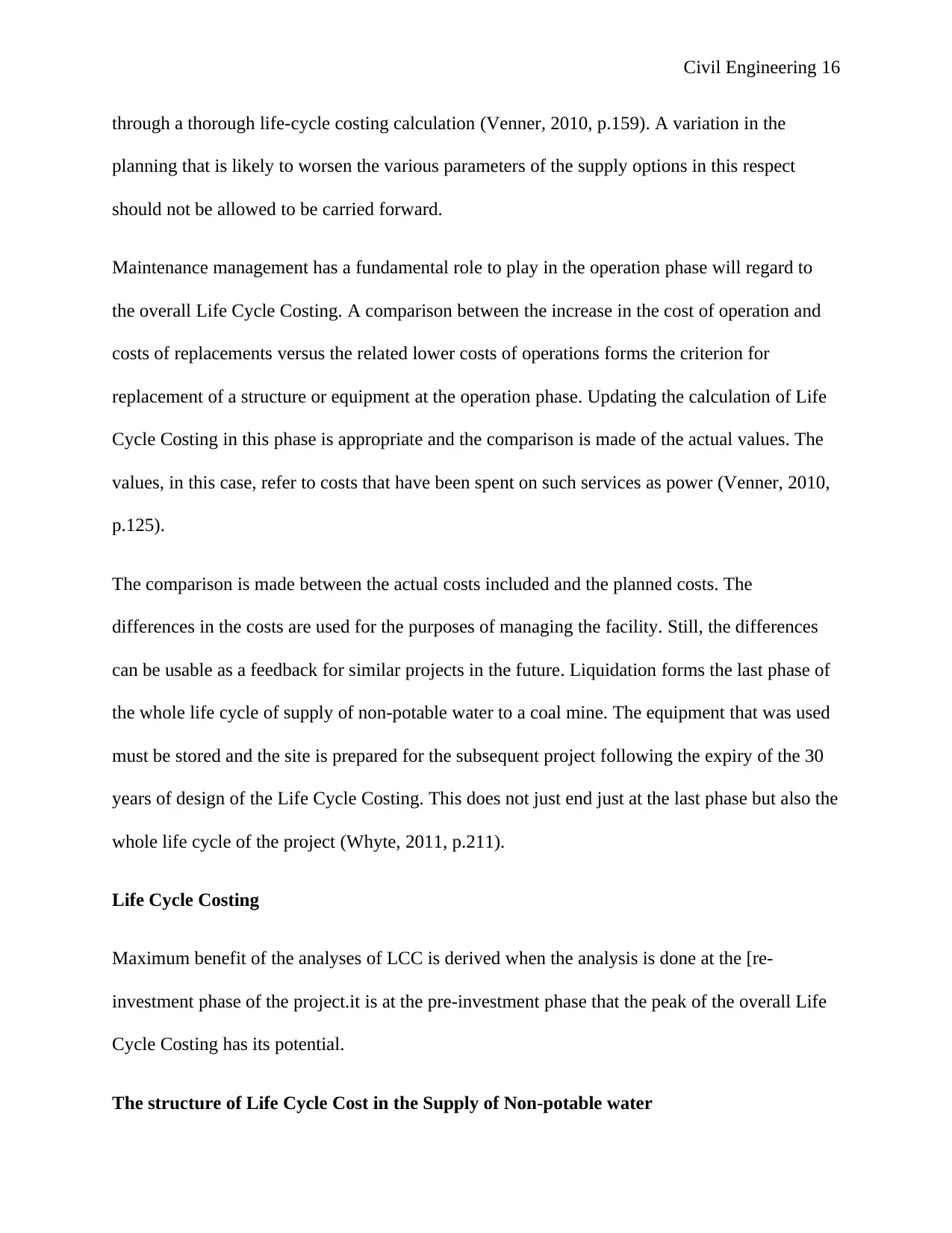
Civil Engineering 16
through a thorough life-cycle costing calculation (Venner, 2010, p.159). A variation in the
planning that is likely to worsen the various parameters of the supply options in this respect
should not be allowed to be carried forward.
Maintenance management has a fundamental role to play in the operation phase will regard to
the overall Life Cycle Costing. A comparison between the increase in the cost of operation and
costs of replacements versus the related lower costs of operations forms the criterion for
replacement of a structure or equipment at the operation phase. Updating the calculation of Life
Cycle Costing in this phase is appropriate and the comparison is made of the actual values. The
values, in this case, refer to costs that have been spent on such services as power (Venner, 2010,
p.125).
The comparison is made between the actual costs included and the planned costs. The
differences in the costs are used for the purposes of managing the facility. Still, the differences
can be usable as a feedback for similar projects in the future. Liquidation forms the last phase of
the whole life cycle of supply of non-potable water to a coal mine. The equipment that was used
must be stored and the site is prepared for the subsequent project following the expiry of the 30
years of design of the Life Cycle Costing. This does not just end just at the last phase but also the
whole life cycle of the project (Whyte, 2011, p.211).
Life Cycle Costing
Maximum benefit of the analyses of LCC is derived when the analysis is done at the [re-
investment phase of the project.it is at the pre-investment phase that the peak of the overall Life
Cycle Costing has its potential.
The structure of Life Cycle Cost in the Supply of Non-potable water
through a thorough life-cycle costing calculation (Venner, 2010, p.159). A variation in the
planning that is likely to worsen the various parameters of the supply options in this respect
should not be allowed to be carried forward.
Maintenance management has a fundamental role to play in the operation phase will regard to
the overall Life Cycle Costing. A comparison between the increase in the cost of operation and
costs of replacements versus the related lower costs of operations forms the criterion for
replacement of a structure or equipment at the operation phase. Updating the calculation of Life
Cycle Costing in this phase is appropriate and the comparison is made of the actual values. The
values, in this case, refer to costs that have been spent on such services as power (Venner, 2010,
p.125).
The comparison is made between the actual costs included and the planned costs. The
differences in the costs are used for the purposes of managing the facility. Still, the differences
can be usable as a feedback for similar projects in the future. Liquidation forms the last phase of
the whole life cycle of supply of non-potable water to a coal mine. The equipment that was used
must be stored and the site is prepared for the subsequent project following the expiry of the 30
years of design of the Life Cycle Costing. This does not just end just at the last phase but also the
whole life cycle of the project (Whyte, 2011, p.211).
Life Cycle Costing
Maximum benefit of the analyses of LCC is derived when the analysis is done at the [re-
investment phase of the project.it is at the pre-investment phase that the peak of the overall Life
Cycle Costing has its potential.
The structure of Life Cycle Cost in the Supply of Non-potable water
Secure Best Marks with AI Grader
Need help grading? Try our AI Grader for instant feedback on your assignments.
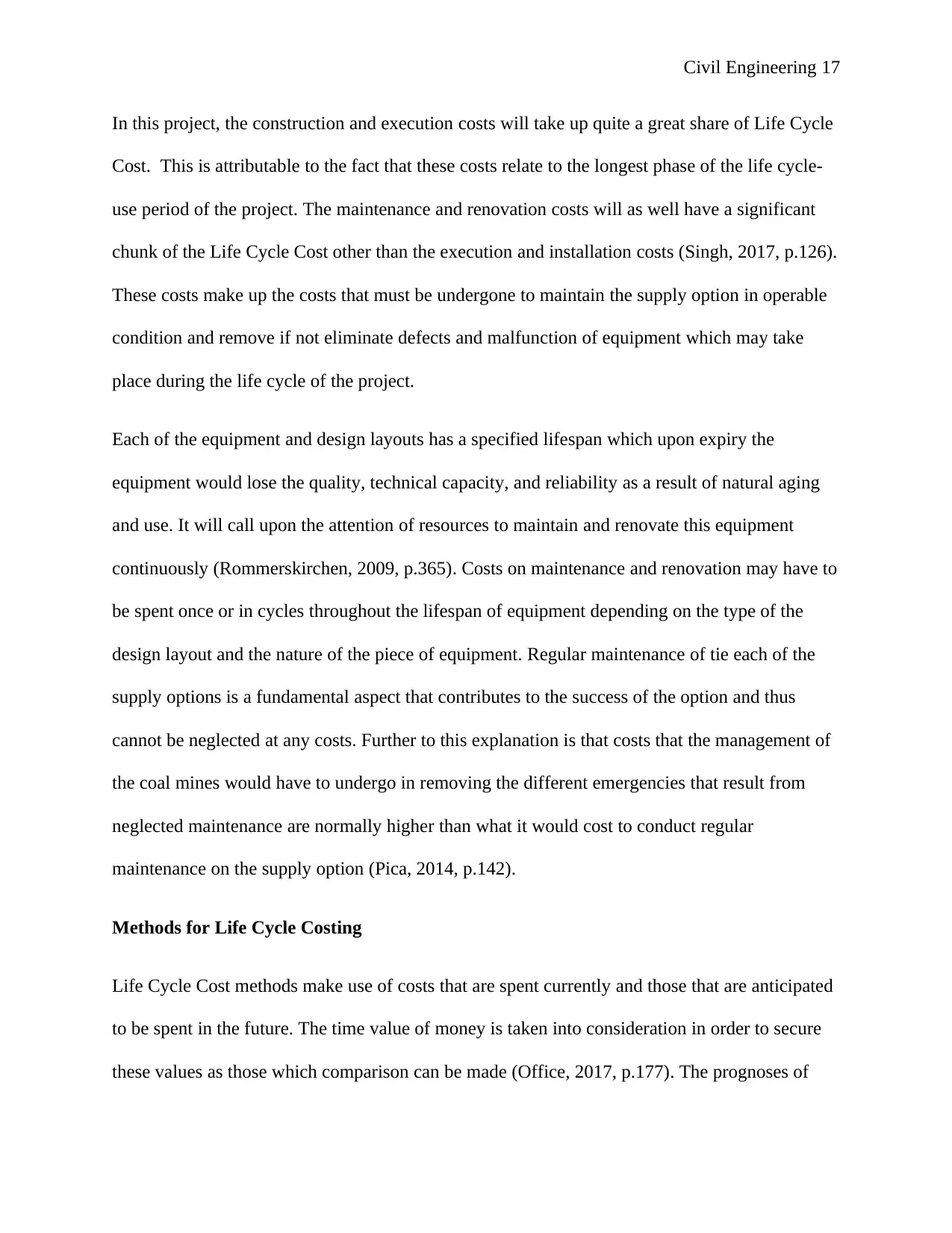
Civil Engineering 17
In this project, the construction and execution costs will take up quite a great share of Life Cycle
Cost. This is attributable to the fact that these costs relate to the longest phase of the life cycle-
use period of the project. The maintenance and renovation costs will as well have a significant
chunk of the Life Cycle Cost other than the execution and installation costs (Singh, 2017, p.126).
These costs make up the costs that must be undergone to maintain the supply option in operable
condition and remove if not eliminate defects and malfunction of equipment which may take
place during the life cycle of the project.
Each of the equipment and design layouts has a specified lifespan which upon expiry the
equipment would lose the quality, technical capacity, and reliability as a result of natural aging
and use. It will call upon the attention of resources to maintain and renovate this equipment
continuously (Rommerskirchen, 2009, p.365). Costs on maintenance and renovation may have to
be spent once or in cycles throughout the lifespan of equipment depending on the type of the
design layout and the nature of the piece of equipment. Regular maintenance of tie each of the
supply options is a fundamental aspect that contributes to the success of the option and thus
cannot be neglected at any costs. Further to this explanation is that costs that the management of
the coal mines would have to undergo in removing the different emergencies that result from
neglected maintenance are normally higher than what it would cost to conduct regular
maintenance on the supply option (Pica, 2014, p.142).
Methods for Life Cycle Costing
Life Cycle Cost methods make use of costs that are spent currently and those that are anticipated
to be spent in the future. The time value of money is taken into consideration in order to secure
these values as those which comparison can be made (Office, 2017, p.177). The prognoses of
In this project, the construction and execution costs will take up quite a great share of Life Cycle
Cost. This is attributable to the fact that these costs relate to the longest phase of the life cycle-
use period of the project. The maintenance and renovation costs will as well have a significant
chunk of the Life Cycle Cost other than the execution and installation costs (Singh, 2017, p.126).
These costs make up the costs that must be undergone to maintain the supply option in operable
condition and remove if not eliminate defects and malfunction of equipment which may take
place during the life cycle of the project.
Each of the equipment and design layouts has a specified lifespan which upon expiry the
equipment would lose the quality, technical capacity, and reliability as a result of natural aging
and use. It will call upon the attention of resources to maintain and renovate this equipment
continuously (Rommerskirchen, 2009, p.365). Costs on maintenance and renovation may have to
be spent once or in cycles throughout the lifespan of equipment depending on the type of the
design layout and the nature of the piece of equipment. Regular maintenance of tie each of the
supply options is a fundamental aspect that contributes to the success of the option and thus
cannot be neglected at any costs. Further to this explanation is that costs that the management of
the coal mines would have to undergo in removing the different emergencies that result from
neglected maintenance are normally higher than what it would cost to conduct regular
maintenance on the supply option (Pica, 2014, p.142).
Methods for Life Cycle Costing
Life Cycle Cost methods make use of costs that are spent currently and those that are anticipated
to be spent in the future. The time value of money is taken into consideration in order to secure
these values as those which comparison can be made (Office, 2017, p.177). The prognoses of
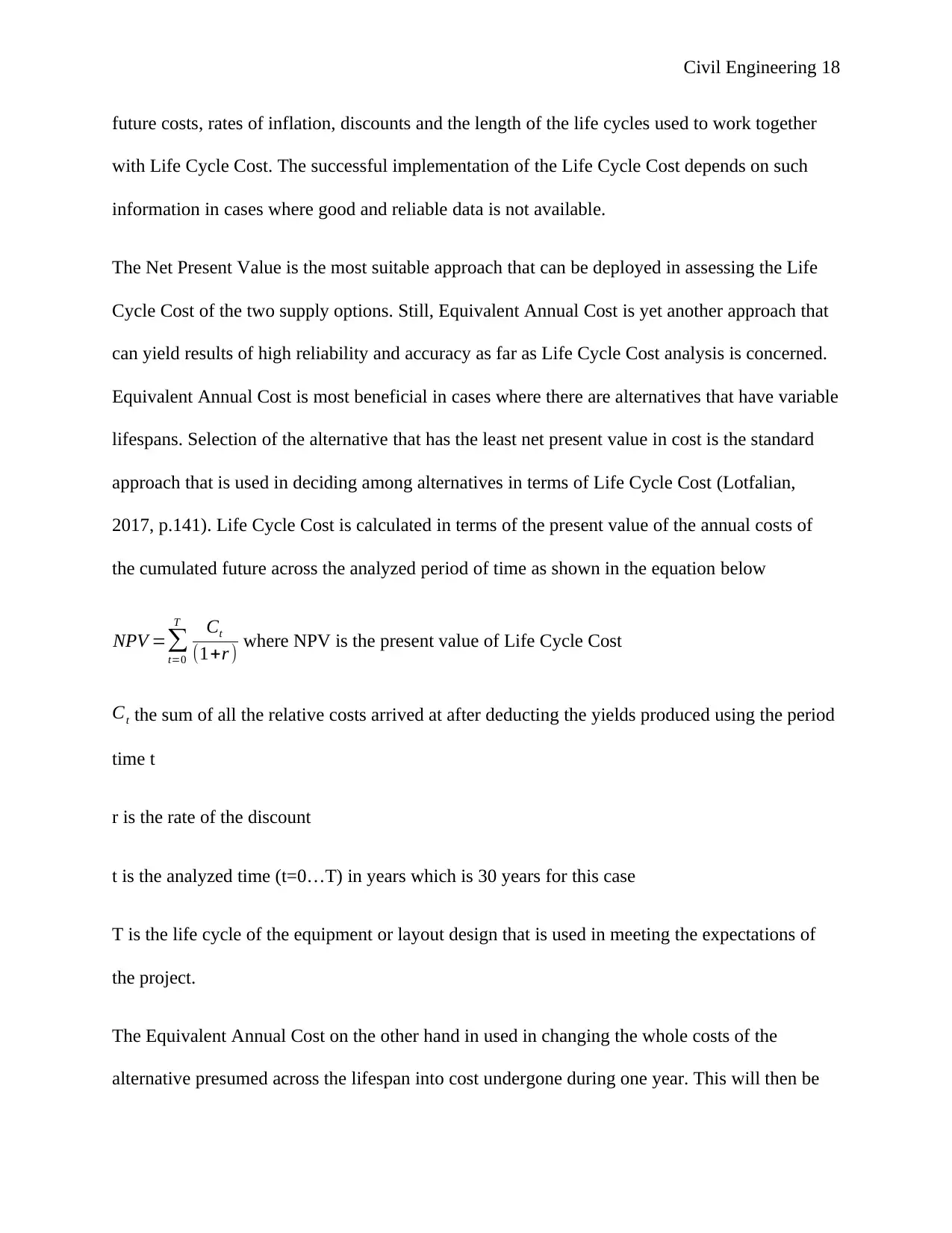
Civil Engineering 18
future costs, rates of inflation, discounts and the length of the life cycles used to work together
with Life Cycle Cost. The successful implementation of the Life Cycle Cost depends on such
information in cases where good and reliable data is not available.
The Net Present Value is the most suitable approach that can be deployed in assessing the Life
Cycle Cost of the two supply options. Still, Equivalent Annual Cost is yet another approach that
can yield results of high reliability and accuracy as far as Life Cycle Cost analysis is concerned.
Equivalent Annual Cost is most beneficial in cases where there are alternatives that have variable
lifespans. Selection of the alternative that has the least net present value in cost is the standard
approach that is used in deciding among alternatives in terms of Life Cycle Cost (Lotfalian,
2017, p.141). Life Cycle Cost is calculated in terms of the present value of the annual costs of
the cumulated future across the analyzed period of time as shown in the equation below
NPV =∑
t=0
T Ct
(1+r ) where NPV is the present value of Life Cycle Cost
Ct the sum of all the relative costs arrived at after deducting the yields produced using the period
time t
r is the rate of the discount
t is the analyzed time (t=0…T) in years which is 30 years for this case
T is the life cycle of the equipment or layout design that is used in meeting the expectations of
the project.
The Equivalent Annual Cost on the other hand in used in changing the whole costs of the
alternative presumed across the lifespan into cost undergone during one year. This will then be
future costs, rates of inflation, discounts and the length of the life cycles used to work together
with Life Cycle Cost. The successful implementation of the Life Cycle Cost depends on such
information in cases where good and reliable data is not available.
The Net Present Value is the most suitable approach that can be deployed in assessing the Life
Cycle Cost of the two supply options. Still, Equivalent Annual Cost is yet another approach that
can yield results of high reliability and accuracy as far as Life Cycle Cost analysis is concerned.
Equivalent Annual Cost is most beneficial in cases where there are alternatives that have variable
lifespans. Selection of the alternative that has the least net present value in cost is the standard
approach that is used in deciding among alternatives in terms of Life Cycle Cost (Lotfalian,
2017, p.141). Life Cycle Cost is calculated in terms of the present value of the annual costs of
the cumulated future across the analyzed period of time as shown in the equation below
NPV =∑
t=0
T Ct
(1+r ) where NPV is the present value of Life Cycle Cost
Ct the sum of all the relative costs arrived at after deducting the yields produced using the period
time t
r is the rate of the discount
t is the analyzed time (t=0…T) in years which is 30 years for this case
T is the life cycle of the equipment or layout design that is used in meeting the expectations of
the project.
The Equivalent Annual Cost on the other hand in used in changing the whole costs of the
alternative presumed across the lifespan into cost undergone during one year. This will then be
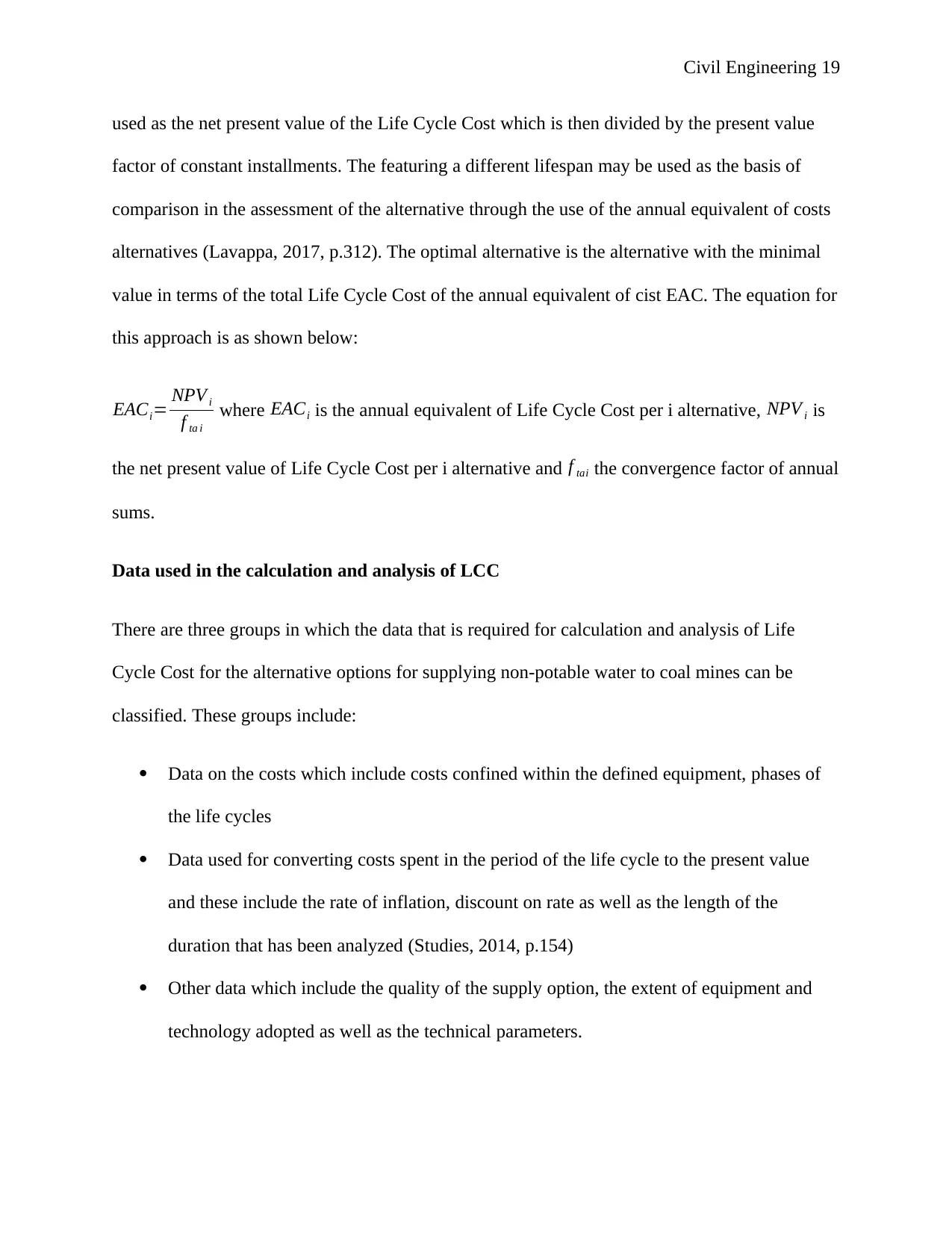
Civil Engineering 19
used as the net present value of the Life Cycle Cost which is then divided by the present value
factor of constant installments. The featuring a different lifespan may be used as the basis of
comparison in the assessment of the alternative through the use of the annual equivalent of costs
alternatives (Lavappa, 2017, p.312). The optimal alternative is the alternative with the minimal
value in terms of the total Life Cycle Cost of the annual equivalent of cist EAC. The equation for
this approach is as shown below:
EACi= NPV i
f ta i
where EACi is the annual equivalent of Life Cycle Cost per i alternative, NPV i is
the net present value of Life Cycle Cost per i alternative and f tai the convergence factor of annual
sums.
Data used in the calculation and analysis of LCC
There are three groups in which the data that is required for calculation and analysis of Life
Cycle Cost for the alternative options for supplying non-potable water to coal mines can be
classified. These groups include:
Data on the costs which include costs confined within the defined equipment, phases of
the life cycles
Data used for converting costs spent in the period of the life cycle to the present value
and these include the rate of inflation, discount on rate as well as the length of the
duration that has been analyzed (Studies, 2014, p.154)
Other data which include the quality of the supply option, the extent of equipment and
technology adopted as well as the technical parameters.
used as the net present value of the Life Cycle Cost which is then divided by the present value
factor of constant installments. The featuring a different lifespan may be used as the basis of
comparison in the assessment of the alternative through the use of the annual equivalent of costs
alternatives (Lavappa, 2017, p.312). The optimal alternative is the alternative with the minimal
value in terms of the total Life Cycle Cost of the annual equivalent of cist EAC. The equation for
this approach is as shown below:
EACi= NPV i
f ta i
where EACi is the annual equivalent of Life Cycle Cost per i alternative, NPV i is
the net present value of Life Cycle Cost per i alternative and f tai the convergence factor of annual
sums.
Data used in the calculation and analysis of LCC
There are three groups in which the data that is required for calculation and analysis of Life
Cycle Cost for the alternative options for supplying non-potable water to coal mines can be
classified. These groups include:
Data on the costs which include costs confined within the defined equipment, phases of
the life cycles
Data used for converting costs spent in the period of the life cycle to the present value
and these include the rate of inflation, discount on rate as well as the length of the
duration that has been analyzed (Studies, 2014, p.154)
Other data which include the quality of the supply option, the extent of equipment and
technology adopted as well as the technical parameters.
Paraphrase This Document
Need a fresh take? Get an instant paraphrase of this document with our AI Paraphraser
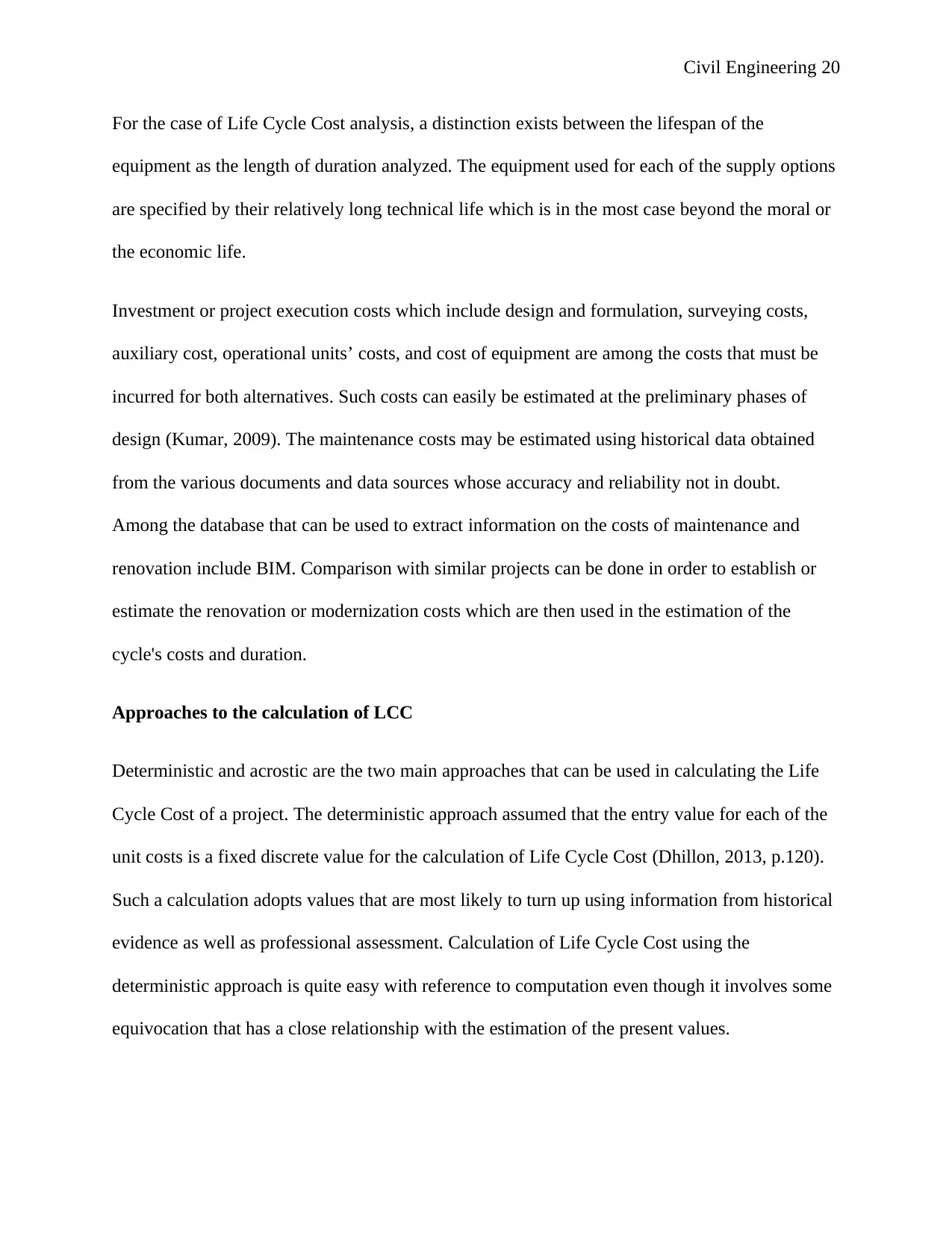
Civil Engineering 20
For the case of Life Cycle Cost analysis, a distinction exists between the lifespan of the
equipment as the length of duration analyzed. The equipment used for each of the supply options
are specified by their relatively long technical life which is in the most case beyond the moral or
the economic life.
Investment or project execution costs which include design and formulation, surveying costs,
auxiliary cost, operational units’ costs, and cost of equipment are among the costs that must be
incurred for both alternatives. Such costs can easily be estimated at the preliminary phases of
design (Kumar, 2009). The maintenance costs may be estimated using historical data obtained
from the various documents and data sources whose accuracy and reliability not in doubt.
Among the database that can be used to extract information on the costs of maintenance and
renovation include BIM. Comparison with similar projects can be done in order to establish or
estimate the renovation or modernization costs which are then used in the estimation of the
cycle's costs and duration.
Approaches to the calculation of LCC
Deterministic and acrostic are the two main approaches that can be used in calculating the Life
Cycle Cost of a project. The deterministic approach assumed that the entry value for each of the
unit costs is a fixed discrete value for the calculation of Life Cycle Cost (Dhillon, 2013, p.120).
Such a calculation adopts values that are most likely to turn up using information from historical
evidence as well as professional assessment. Calculation of Life Cycle Cost using the
deterministic approach is quite easy with reference to computation even though it involves some
equivocation that has a close relationship with the estimation of the present values.
For the case of Life Cycle Cost analysis, a distinction exists between the lifespan of the
equipment as the length of duration analyzed. The equipment used for each of the supply options
are specified by their relatively long technical life which is in the most case beyond the moral or
the economic life.
Investment or project execution costs which include design and formulation, surveying costs,
auxiliary cost, operational units’ costs, and cost of equipment are among the costs that must be
incurred for both alternatives. Such costs can easily be estimated at the preliminary phases of
design (Kumar, 2009). The maintenance costs may be estimated using historical data obtained
from the various documents and data sources whose accuracy and reliability not in doubt.
Among the database that can be used to extract information on the costs of maintenance and
renovation include BIM. Comparison with similar projects can be done in order to establish or
estimate the renovation or modernization costs which are then used in the estimation of the
cycle's costs and duration.
Approaches to the calculation of LCC
Deterministic and acrostic are the two main approaches that can be used in calculating the Life
Cycle Cost of a project. The deterministic approach assumed that the entry value for each of the
unit costs is a fixed discrete value for the calculation of Life Cycle Cost (Dhillon, 2013, p.120).
Such a calculation adopts values that are most likely to turn up using information from historical
evidence as well as professional assessment. Calculation of Life Cycle Cost using the
deterministic approach is quite easy with reference to computation even though it involves some
equivocation that has a close relationship with the estimation of the present values.
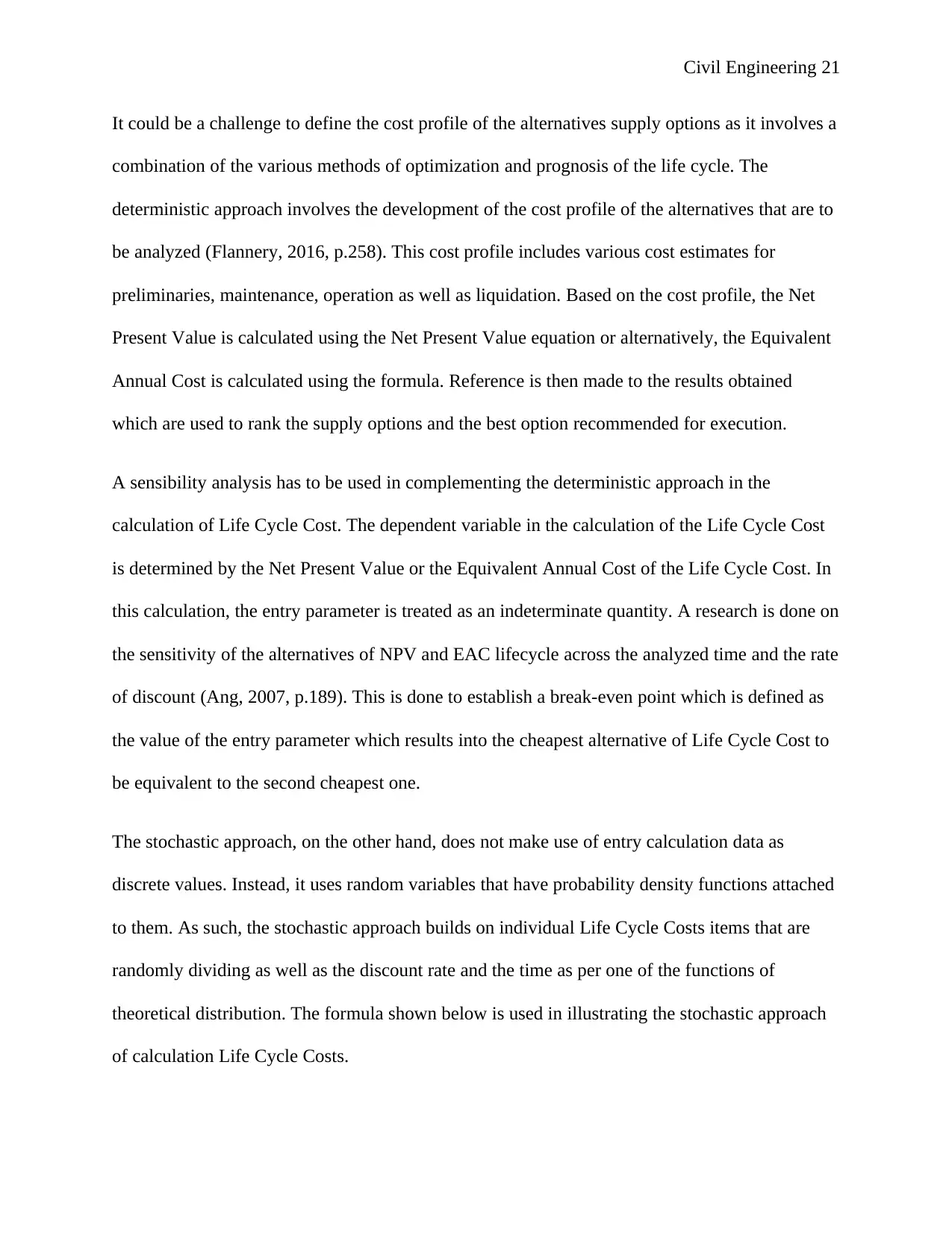
Civil Engineering 21
It could be a challenge to define the cost profile of the alternatives supply options as it involves a
combination of the various methods of optimization and prognosis of the life cycle. The
deterministic approach involves the development of the cost profile of the alternatives that are to
be analyzed (Flannery, 2016, p.258). This cost profile includes various cost estimates for
preliminaries, maintenance, operation as well as liquidation. Based on the cost profile, the Net
Present Value is calculated using the Net Present Value equation or alternatively, the Equivalent
Annual Cost is calculated using the formula. Reference is then made to the results obtained
which are used to rank the supply options and the best option recommended for execution.
A sensibility analysis has to be used in complementing the deterministic approach in the
calculation of Life Cycle Cost. The dependent variable in the calculation of the Life Cycle Cost
is determined by the Net Present Value or the Equivalent Annual Cost of the Life Cycle Cost. In
this calculation, the entry parameter is treated as an indeterminate quantity. A research is done on
the sensitivity of the alternatives of NPV and EAC lifecycle across the analyzed time and the rate
of discount (Ang, 2007, p.189). This is done to establish a break-even point which is defined as
the value of the entry parameter which results into the cheapest alternative of Life Cycle Cost to
be equivalent to the second cheapest one.
The stochastic approach, on the other hand, does not make use of entry calculation data as
discrete values. Instead, it uses random variables that have probability density functions attached
to them. As such, the stochastic approach builds on individual Life Cycle Costs items that are
randomly dividing as well as the discount rate and the time as per one of the functions of
theoretical distribution. The formula shown below is used in illustrating the stochastic approach
of calculation Life Cycle Costs.
It could be a challenge to define the cost profile of the alternatives supply options as it involves a
combination of the various methods of optimization and prognosis of the life cycle. The
deterministic approach involves the development of the cost profile of the alternatives that are to
be analyzed (Flannery, 2016, p.258). This cost profile includes various cost estimates for
preliminaries, maintenance, operation as well as liquidation. Based on the cost profile, the Net
Present Value is calculated using the Net Present Value equation or alternatively, the Equivalent
Annual Cost is calculated using the formula. Reference is then made to the results obtained
which are used to rank the supply options and the best option recommended for execution.
A sensibility analysis has to be used in complementing the deterministic approach in the
calculation of Life Cycle Cost. The dependent variable in the calculation of the Life Cycle Cost
is determined by the Net Present Value or the Equivalent Annual Cost of the Life Cycle Cost. In
this calculation, the entry parameter is treated as an indeterminate quantity. A research is done on
the sensitivity of the alternatives of NPV and EAC lifecycle across the analyzed time and the rate
of discount (Ang, 2007, p.189). This is done to establish a break-even point which is defined as
the value of the entry parameter which results into the cheapest alternative of Life Cycle Cost to
be equivalent to the second cheapest one.
The stochastic approach, on the other hand, does not make use of entry calculation data as
discrete values. Instead, it uses random variables that have probability density functions attached
to them. As such, the stochastic approach builds on individual Life Cycle Costs items that are
randomly dividing as well as the discount rate and the time as per one of the functions of
theoretical distribution. The formula shown below is used in illustrating the stochastic approach
of calculation Life Cycle Costs.
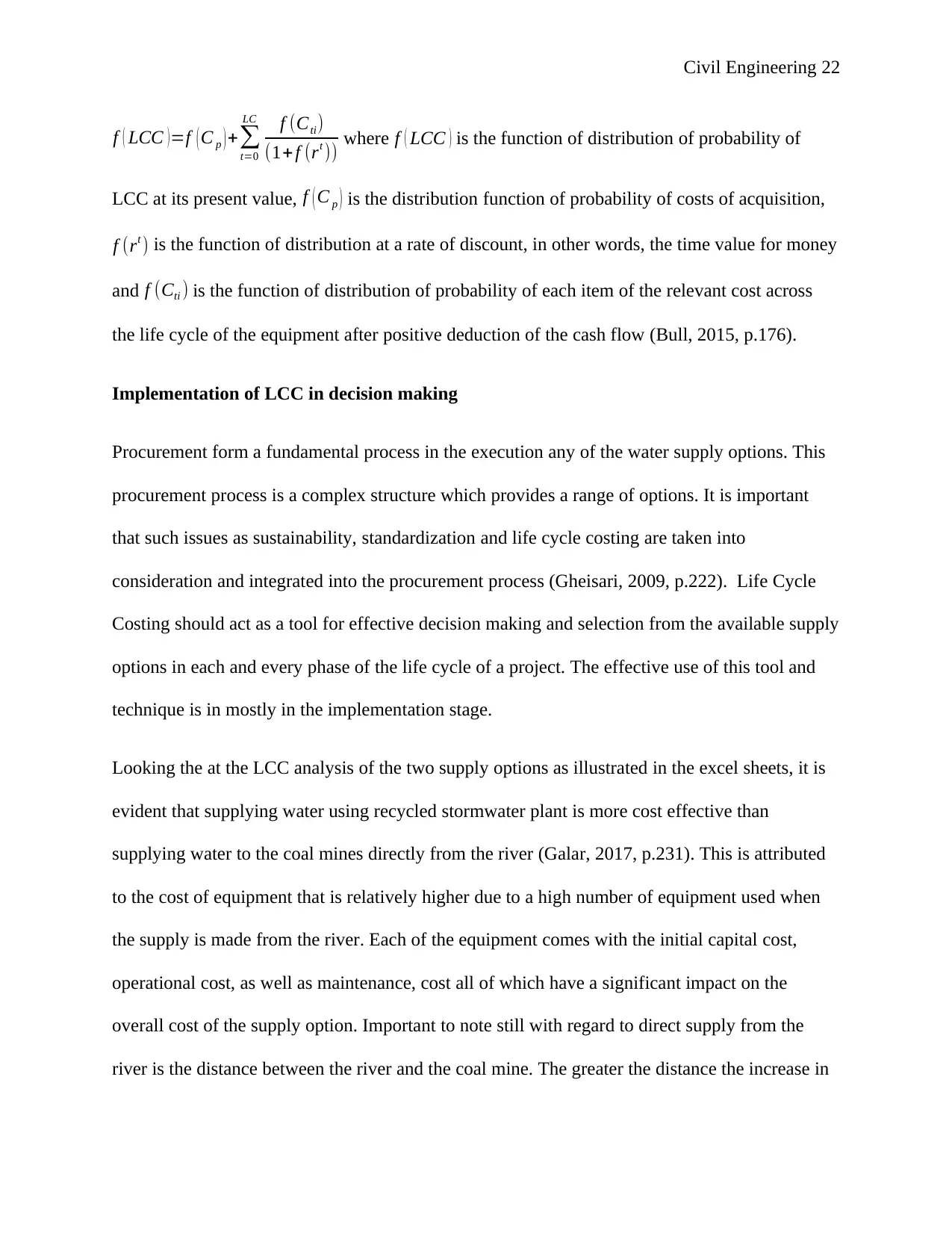
Civil Engineering 22
f ( LCC ) =f ( C p ) +∑
t=0
LC f (Cti)
(1+ f (rt )) where f ( LCC ) is the function of distribution of probability of
LCC at its present value, f ( C p ) is the distribution function of probability of costs of acquisition,
f (rt ) is the function of distribution at a rate of discount, in other words, the time value for money
and f (Cti ) is the function of distribution of probability of each item of the relevant cost across
the life cycle of the equipment after positive deduction of the cash flow (Bull, 2015, p.176).
Implementation of LCC in decision making
Procurement form a fundamental process in the execution any of the water supply options. This
procurement process is a complex structure which provides a range of options. It is important
that such issues as sustainability, standardization and life cycle costing are taken into
consideration and integrated into the procurement process (Gheisari, 2009, p.222). Life Cycle
Costing should act as a tool for effective decision making and selection from the available supply
options in each and every phase of the life cycle of a project. The effective use of this tool and
technique is in mostly in the implementation stage.
Looking the at the LCC analysis of the two supply options as illustrated in the excel sheets, it is
evident that supplying water using recycled stormwater plant is more cost effective than
supplying water to the coal mines directly from the river (Galar, 2017, p.231). This is attributed
to the cost of equipment that is relatively higher due to a high number of equipment used when
the supply is made from the river. Each of the equipment comes with the initial capital cost,
operational cost, as well as maintenance, cost all of which have a significant impact on the
overall cost of the supply option. Important to note still with regard to direct supply from the
river is the distance between the river and the coal mine. The greater the distance the increase in
f ( LCC ) =f ( C p ) +∑
t=0
LC f (Cti)
(1+ f (rt )) where f ( LCC ) is the function of distribution of probability of
LCC at its present value, f ( C p ) is the distribution function of probability of costs of acquisition,
f (rt ) is the function of distribution at a rate of discount, in other words, the time value for money
and f (Cti ) is the function of distribution of probability of each item of the relevant cost across
the life cycle of the equipment after positive deduction of the cash flow (Bull, 2015, p.176).
Implementation of LCC in decision making
Procurement form a fundamental process in the execution any of the water supply options. This
procurement process is a complex structure which provides a range of options. It is important
that such issues as sustainability, standardization and life cycle costing are taken into
consideration and integrated into the procurement process (Gheisari, 2009, p.222). Life Cycle
Costing should act as a tool for effective decision making and selection from the available supply
options in each and every phase of the life cycle of a project. The effective use of this tool and
technique is in mostly in the implementation stage.
Looking the at the LCC analysis of the two supply options as illustrated in the excel sheets, it is
evident that supplying water using recycled stormwater plant is more cost effective than
supplying water to the coal mines directly from the river (Galar, 2017, p.231). This is attributed
to the cost of equipment that is relatively higher due to a high number of equipment used when
the supply is made from the river. Each of the equipment comes with the initial capital cost,
operational cost, as well as maintenance, cost all of which have a significant impact on the
overall cost of the supply option. Important to note still with regard to direct supply from the
river is the distance between the river and the coal mine. The greater the distance the increase in
Secure Best Marks with AI Grader
Need help grading? Try our AI Grader for instant feedback on your assignments.
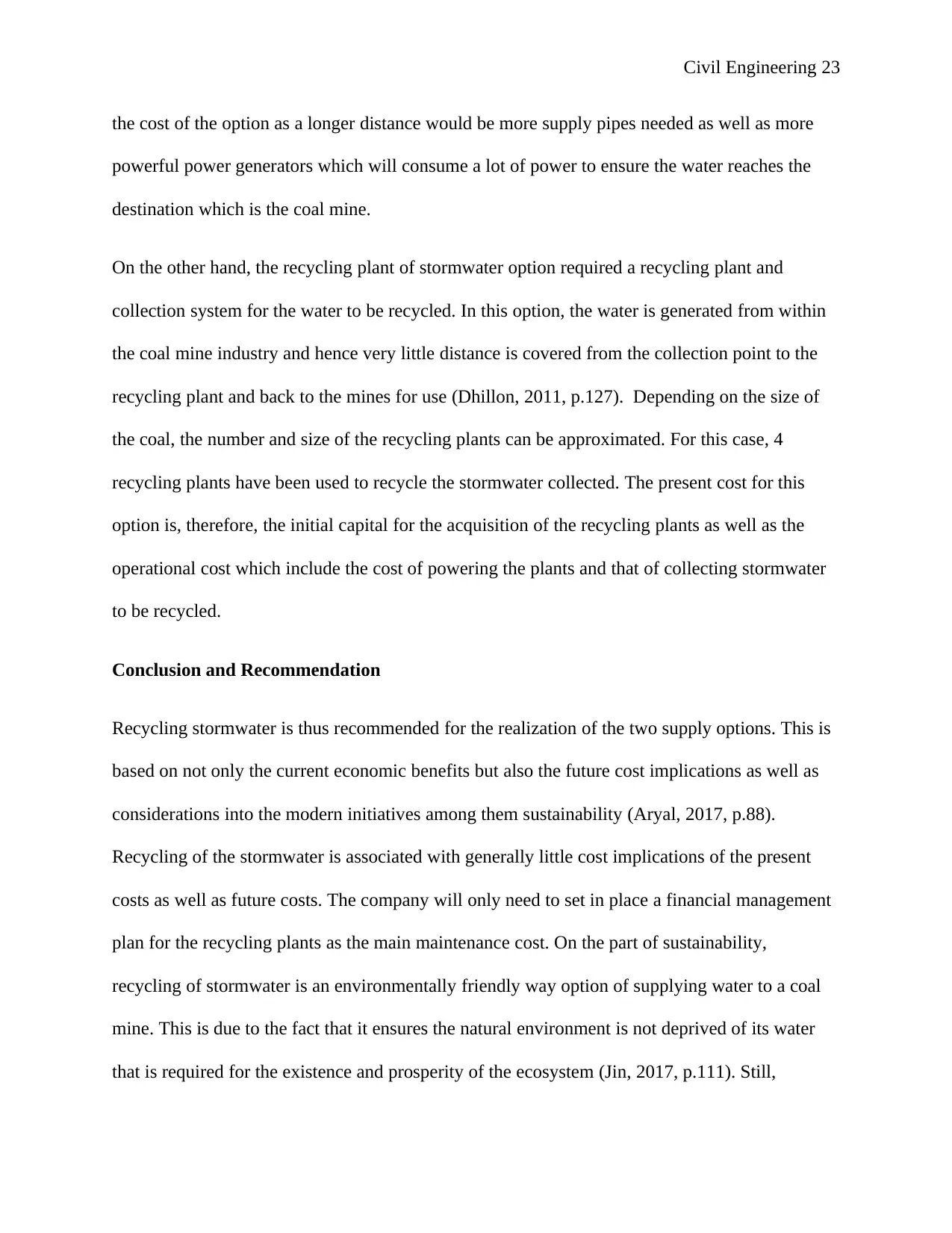
Civil Engineering 23
the cost of the option as a longer distance would be more supply pipes needed as well as more
powerful power generators which will consume a lot of power to ensure the water reaches the
destination which is the coal mine.
On the other hand, the recycling plant of stormwater option required a recycling plant and
collection system for the water to be recycled. In this option, the water is generated from within
the coal mine industry and hence very little distance is covered from the collection point to the
recycling plant and back to the mines for use (Dhillon, 2011, p.127). Depending on the size of
the coal, the number and size of the recycling plants can be approximated. For this case, 4
recycling plants have been used to recycle the stormwater collected. The present cost for this
option is, therefore, the initial capital for the acquisition of the recycling plants as well as the
operational cost which include the cost of powering the plants and that of collecting stormwater
to be recycled.
Conclusion and Recommendation
Recycling stormwater is thus recommended for the realization of the two supply options. This is
based on not only the current economic benefits but also the future cost implications as well as
considerations into the modern initiatives among them sustainability (Aryal, 2017, p.88).
Recycling of the stormwater is associated with generally little cost implications of the present
costs as well as future costs. The company will only need to set in place a financial management
plan for the recycling plants as the main maintenance cost. On the part of sustainability,
recycling of stormwater is an environmentally friendly way option of supplying water to a coal
mine. This is due to the fact that it ensures the natural environment is not deprived of its water
that is required for the existence and prosperity of the ecosystem (Jin, 2017, p.111). Still,
the cost of the option as a longer distance would be more supply pipes needed as well as more
powerful power generators which will consume a lot of power to ensure the water reaches the
destination which is the coal mine.
On the other hand, the recycling plant of stormwater option required a recycling plant and
collection system for the water to be recycled. In this option, the water is generated from within
the coal mine industry and hence very little distance is covered from the collection point to the
recycling plant and back to the mines for use (Dhillon, 2011, p.127). Depending on the size of
the coal, the number and size of the recycling plants can be approximated. For this case, 4
recycling plants have been used to recycle the stormwater collected. The present cost for this
option is, therefore, the initial capital for the acquisition of the recycling plants as well as the
operational cost which include the cost of powering the plants and that of collecting stormwater
to be recycled.
Conclusion and Recommendation
Recycling stormwater is thus recommended for the realization of the two supply options. This is
based on not only the current economic benefits but also the future cost implications as well as
considerations into the modern initiatives among them sustainability (Aryal, 2017, p.88).
Recycling of the stormwater is associated with generally little cost implications of the present
costs as well as future costs. The company will only need to set in place a financial management
plan for the recycling plants as the main maintenance cost. On the part of sustainability,
recycling of stormwater is an environmentally friendly way option of supplying water to a coal
mine. This is due to the fact that it ensures the natural environment is not deprived of its water
that is required for the existence and prosperity of the ecosystem (Jin, 2017, p.111). Still,
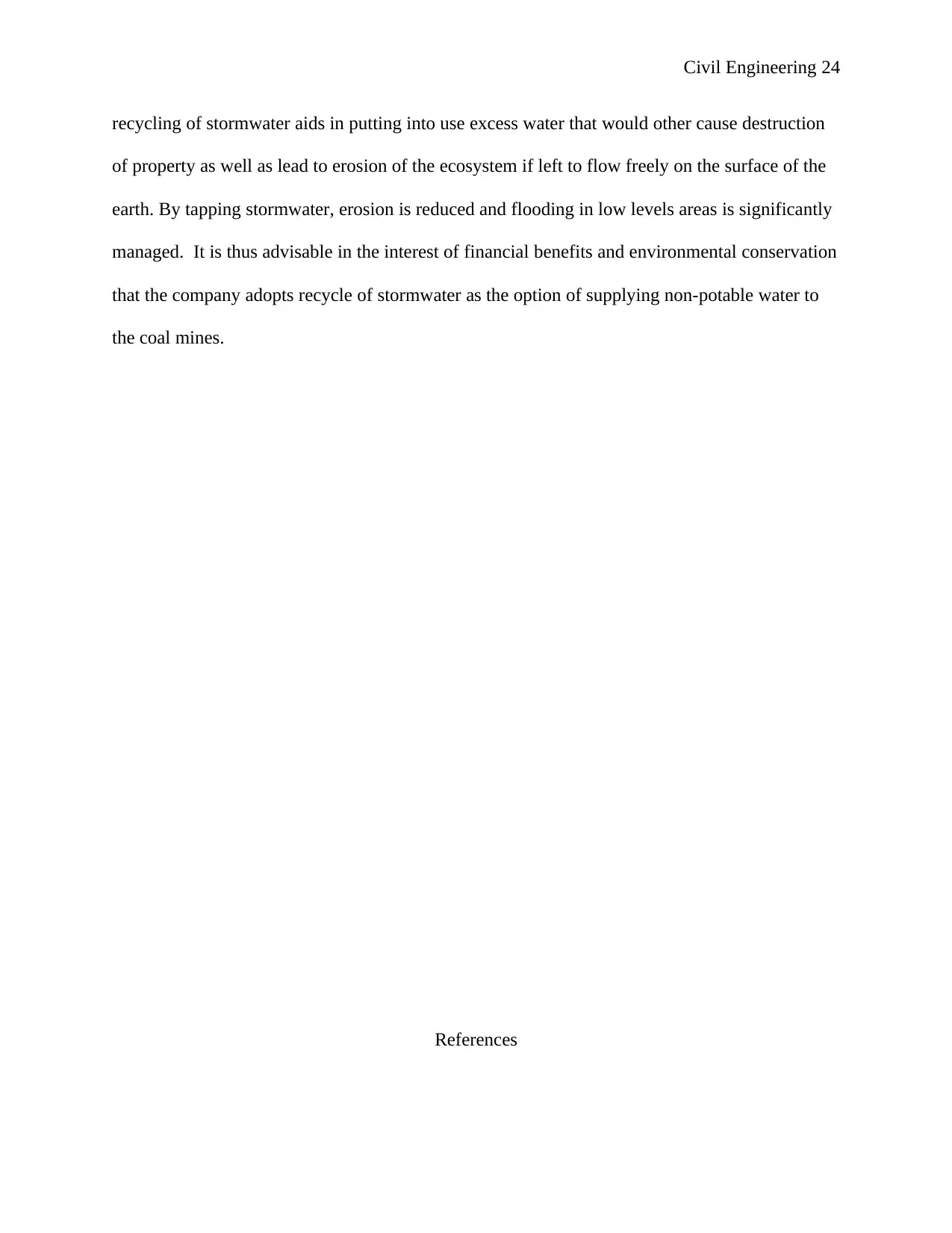
Civil Engineering 24
recycling of stormwater aids in putting into use excess water that would other cause destruction
of property as well as lead to erosion of the ecosystem if left to flow freely on the surface of the
earth. By tapping stormwater, erosion is reduced and flooding in low levels areas is significantly
managed. It is thus advisable in the interest of financial benefits and environmental conservation
that the company adopts recycle of stormwater as the option of supplying non-potable water to
the coal mines.
References
recycling of stormwater aids in putting into use excess water that would other cause destruction
of property as well as lead to erosion of the ecosystem if left to flow freely on the surface of the
earth. By tapping stormwater, erosion is reduced and flooding in low levels areas is significantly
managed. It is thus advisable in the interest of financial benefits and environmental conservation
that the company adopts recycle of stormwater as the option of supplying non-potable water to
the coal mines.
References
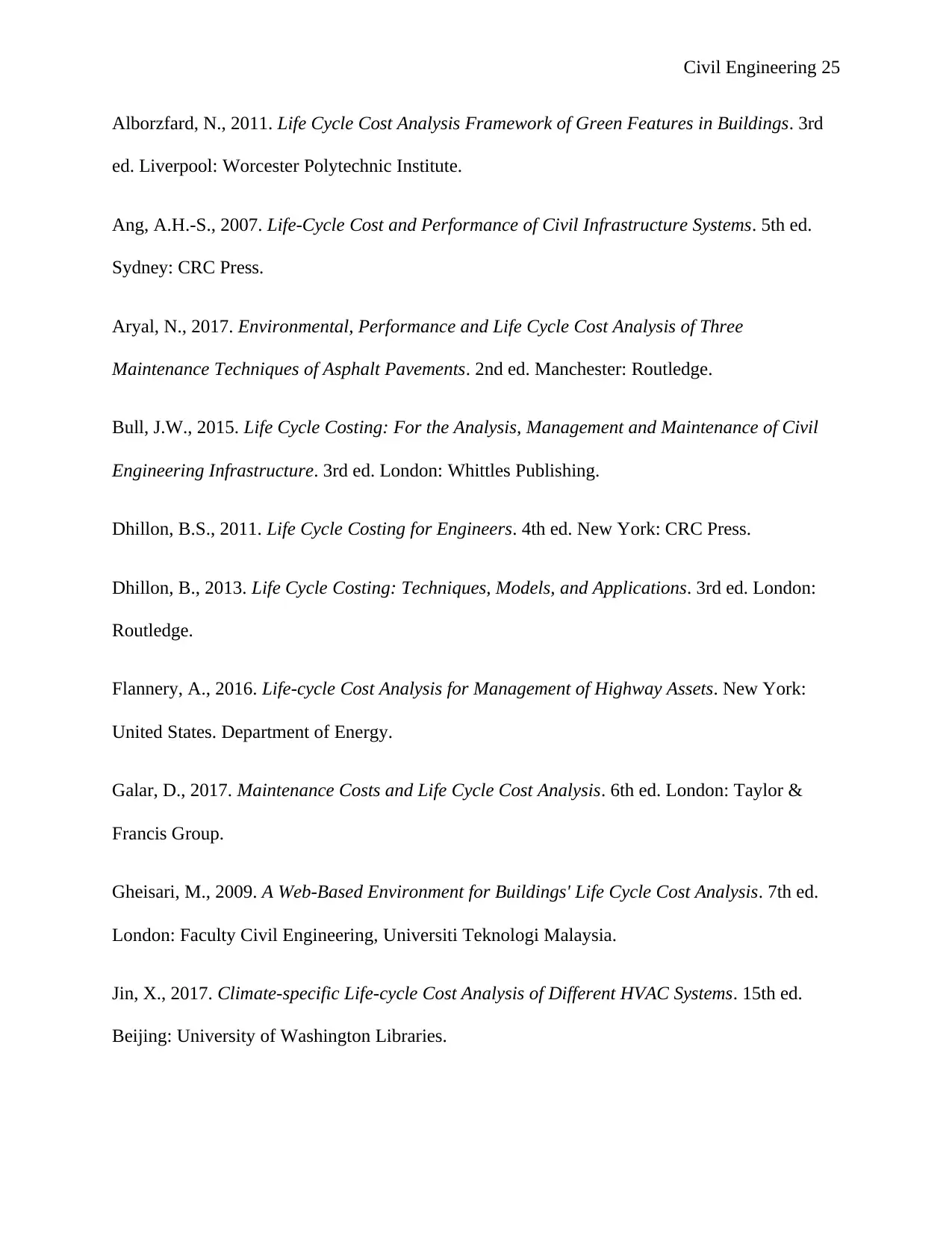
Civil Engineering 25
Alborzfard, N., 2011. Life Cycle Cost Analysis Framework of Green Features in Buildings. 3rd
ed. Liverpool: Worcester Polytechnic Institute.
Ang, A.H.-S., 2007. Life-Cycle Cost and Performance of Civil Infrastructure Systems. 5th ed.
Sydney: CRC Press.
Aryal, N., 2017. Environmental, Performance and Life Cycle Cost Analysis of Three
Maintenance Techniques of Asphalt Pavements. 2nd ed. Manchester: Routledge.
Bull, J.W., 2015. Life Cycle Costing: For the Analysis, Management and Maintenance of Civil
Engineering Infrastructure. 3rd ed. London: Whittles Publishing.
Dhillon, B.S., 2011. Life Cycle Costing for Engineers. 4th ed. New York: CRC Press.
Dhillon, B., 2013. Life Cycle Costing: Techniques, Models, and Applications. 3rd ed. London:
Routledge.
Flannery, A., 2016. Life-cycle Cost Analysis for Management of Highway Assets. New York:
United States. Department of Energy.
Galar, D., 2017. Maintenance Costs and Life Cycle Cost Analysis. 6th ed. London: Taylor &
Francis Group.
Gheisari, M., 2009. A Web-Based Environment for Buildings' Life Cycle Cost Analysis. 7th ed.
London: Faculty Civil Engineering, Universiti Teknologi Malaysia.
Jin, X., 2017. Climate-specific Life-cycle Cost Analysis of Different HVAC Systems. 15th ed.
Beijing: University of Washington Libraries.
Alborzfard, N., 2011. Life Cycle Cost Analysis Framework of Green Features in Buildings. 3rd
ed. Liverpool: Worcester Polytechnic Institute.
Ang, A.H.-S., 2007. Life-Cycle Cost and Performance of Civil Infrastructure Systems. 5th ed.
Sydney: CRC Press.
Aryal, N., 2017. Environmental, Performance and Life Cycle Cost Analysis of Three
Maintenance Techniques of Asphalt Pavements. 2nd ed. Manchester: Routledge.
Bull, J.W., 2015. Life Cycle Costing: For the Analysis, Management and Maintenance of Civil
Engineering Infrastructure. 3rd ed. London: Whittles Publishing.
Dhillon, B.S., 2011. Life Cycle Costing for Engineers. 4th ed. New York: CRC Press.
Dhillon, B., 2013. Life Cycle Costing: Techniques, Models, and Applications. 3rd ed. London:
Routledge.
Flannery, A., 2016. Life-cycle Cost Analysis for Management of Highway Assets. New York:
United States. Department of Energy.
Galar, D., 2017. Maintenance Costs and Life Cycle Cost Analysis. 6th ed. London: Taylor &
Francis Group.
Gheisari, M., 2009. A Web-Based Environment for Buildings' Life Cycle Cost Analysis. 7th ed.
London: Faculty Civil Engineering, Universiti Teknologi Malaysia.
Jin, X., 2017. Climate-specific Life-cycle Cost Analysis of Different HVAC Systems. 15th ed.
Beijing: University of Washington Libraries.
Paraphrase This Document
Need a fresh take? Get an instant paraphrase of this document with our AI Paraphraser
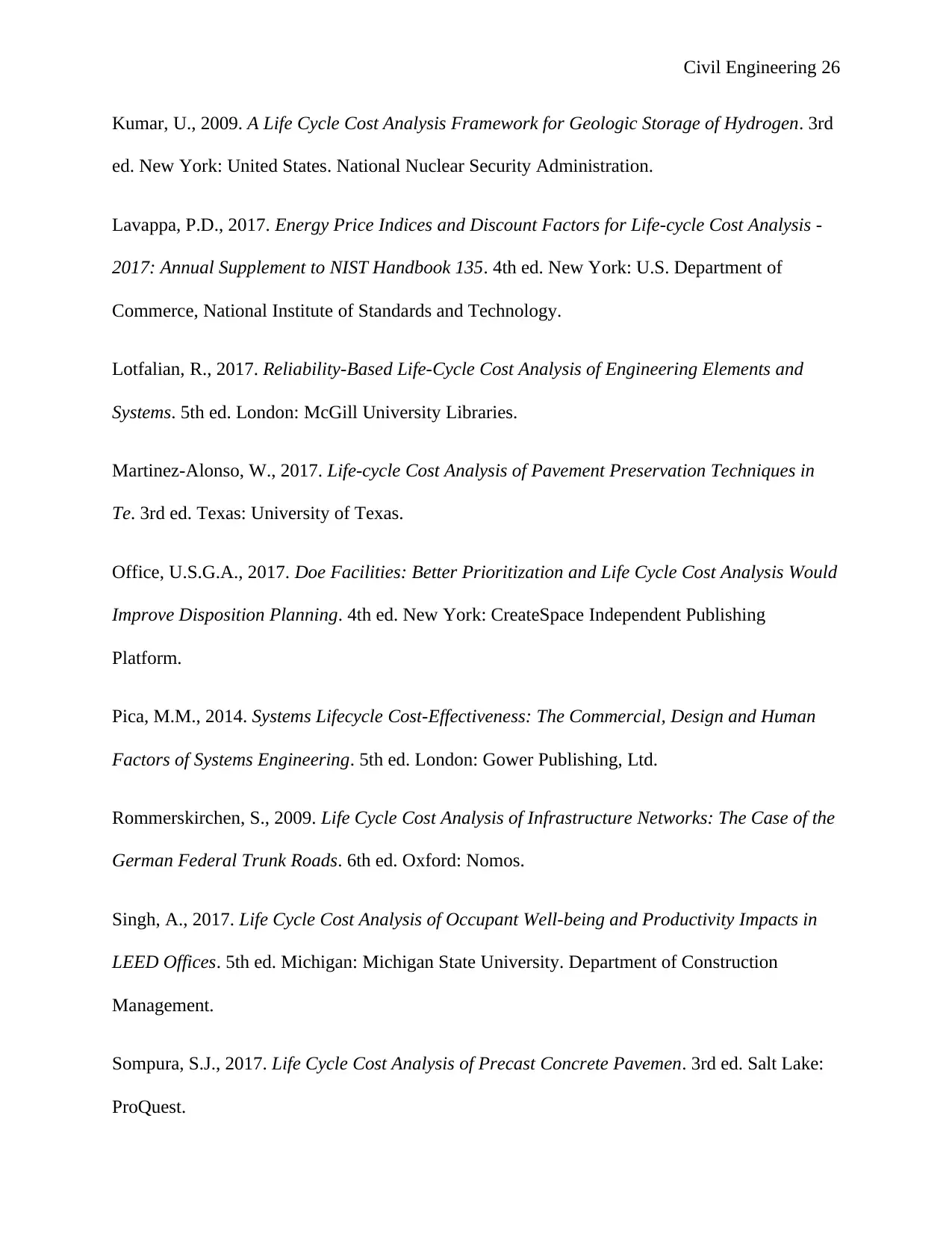
Civil Engineering 26
Kumar, U., 2009. A Life Cycle Cost Analysis Framework for Geologic Storage of Hydrogen. 3rd
ed. New York: United States. National Nuclear Security Administration.
Lavappa, P.D., 2017. Energy Price Indices and Discount Factors for Life-cycle Cost Analysis -
2017: Annual Supplement to NIST Handbook 135. 4th ed. New York: U.S. Department of
Commerce, National Institute of Standards and Technology.
Lotfalian, R., 2017. Reliability-Based Life-Cycle Cost Analysis of Engineering Elements and
Systems. 5th ed. London: McGill University Libraries.
Martinez-Alonso, W., 2017. Life-cycle Cost Analysis of Pavement Preservation Techniques in
Te. 3rd ed. Texas: University of Texas.
Office, U.S.G.A., 2017. Doe Facilities: Better Prioritization and Life Cycle Cost Analysis Would
Improve Disposition Planning. 4th ed. New York: CreateSpace Independent Publishing
Platform.
Pica, M.M., 2014. Systems Lifecycle Cost-Effectiveness: The Commercial, Design and Human
Factors of Systems Engineering. 5th ed. London: Gower Publishing, Ltd.
Rommerskirchen, S., 2009. Life Cycle Cost Analysis of Infrastructure Networks: The Case of the
German Federal Trunk Roads. 6th ed. Oxford: Nomos.
Singh, A., 2017. Life Cycle Cost Analysis of Occupant Well-being and Productivity Impacts in
LEED Offices. 5th ed. Michigan: Michigan State University. Department of Construction
Management.
Sompura, S.J., 2017. Life Cycle Cost Analysis of Precast Concrete Pavemen. 3rd ed. Salt Lake:
ProQuest.
Kumar, U., 2009. A Life Cycle Cost Analysis Framework for Geologic Storage of Hydrogen. 3rd
ed. New York: United States. National Nuclear Security Administration.
Lavappa, P.D., 2017. Energy Price Indices and Discount Factors for Life-cycle Cost Analysis -
2017: Annual Supplement to NIST Handbook 135. 4th ed. New York: U.S. Department of
Commerce, National Institute of Standards and Technology.
Lotfalian, R., 2017. Reliability-Based Life-Cycle Cost Analysis of Engineering Elements and
Systems. 5th ed. London: McGill University Libraries.
Martinez-Alonso, W., 2017. Life-cycle Cost Analysis of Pavement Preservation Techniques in
Te. 3rd ed. Texas: University of Texas.
Office, U.S.G.A., 2017. Doe Facilities: Better Prioritization and Life Cycle Cost Analysis Would
Improve Disposition Planning. 4th ed. New York: CreateSpace Independent Publishing
Platform.
Pica, M.M., 2014. Systems Lifecycle Cost-Effectiveness: The Commercial, Design and Human
Factors of Systems Engineering. 5th ed. London: Gower Publishing, Ltd.
Rommerskirchen, S., 2009. Life Cycle Cost Analysis of Infrastructure Networks: The Case of the
German Federal Trunk Roads. 6th ed. Oxford: Nomos.
Singh, A., 2017. Life Cycle Cost Analysis of Occupant Well-being and Productivity Impacts in
LEED Offices. 5th ed. Michigan: Michigan State University. Department of Construction
Management.
Sompura, S.J., 2017. Life Cycle Cost Analysis of Precast Concrete Pavemen. 3rd ed. Salt Lake:
ProQuest.
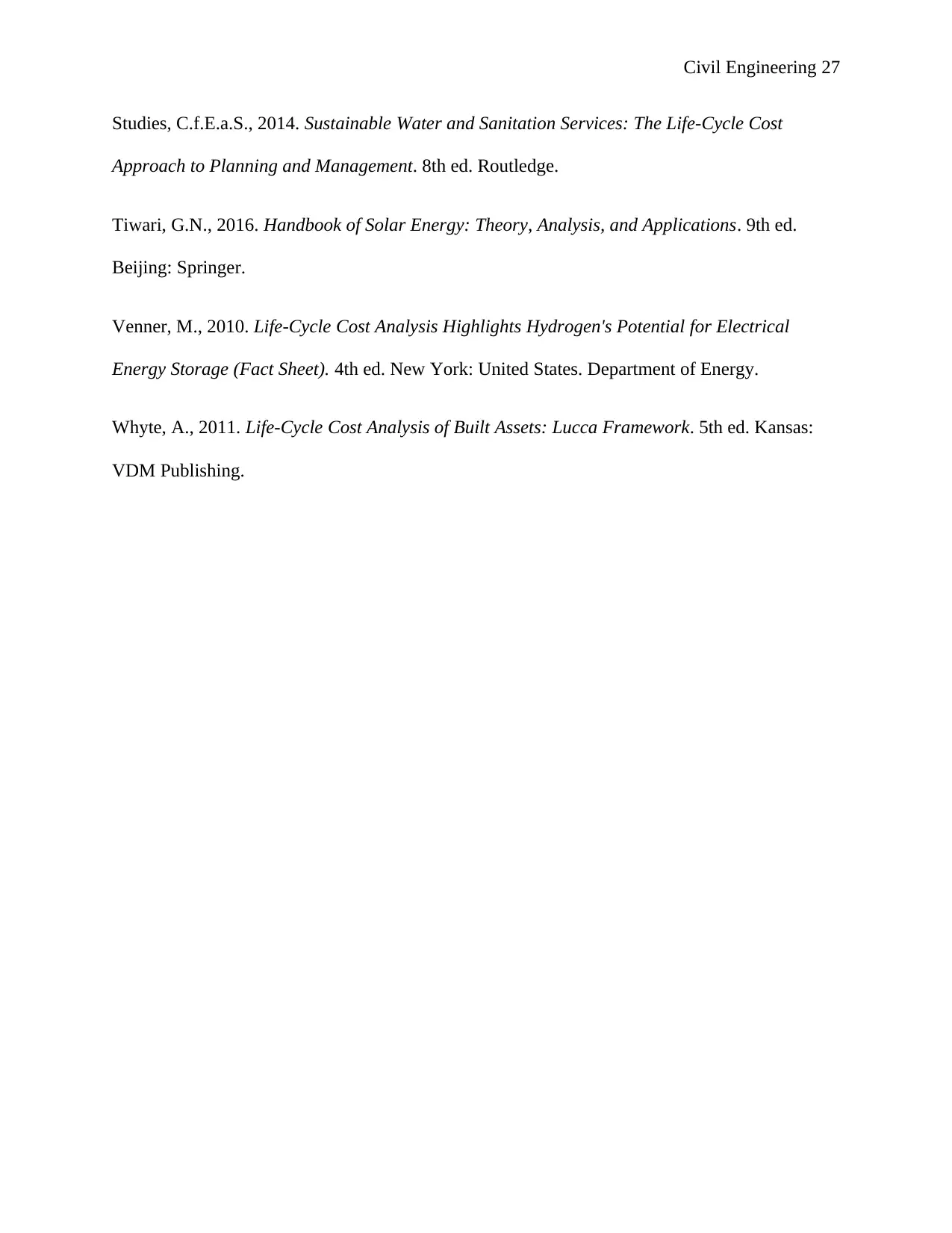
Civil Engineering 27
Studies, C.f.E.a.S., 2014. Sustainable Water and Sanitation Services: The Life-Cycle Cost
Approach to Planning and Management. 8th ed. Routledge.
Tiwari, G.N., 2016. Handbook of Solar Energy: Theory, Analysis, and Applications. 9th ed.
Beijing: Springer.
Venner, M., 2010. Life-Cycle Cost Analysis Highlights Hydrogen's Potential for Electrical
Energy Storage (Fact Sheet). 4th ed. New York: United States. Department of Energy.
Whyte, A., 2011. Life-Cycle Cost Analysis of Built Assets: Lucca Framework. 5th ed. Kansas:
VDM Publishing.
Studies, C.f.E.a.S., 2014. Sustainable Water and Sanitation Services: The Life-Cycle Cost
Approach to Planning and Management. 8th ed. Routledge.
Tiwari, G.N., 2016. Handbook of Solar Energy: Theory, Analysis, and Applications. 9th ed.
Beijing: Springer.
Venner, M., 2010. Life-Cycle Cost Analysis Highlights Hydrogen's Potential for Electrical
Energy Storage (Fact Sheet). 4th ed. New York: United States. Department of Energy.
Whyte, A., 2011. Life-Cycle Cost Analysis of Built Assets: Lucca Framework. 5th ed. Kansas:
VDM Publishing.
1 out of 27
Your All-in-One AI-Powered Toolkit for Academic Success.
+13062052269
info@desklib.com
Available 24*7 on WhatsApp / Email
![[object Object]](/_next/static/media/star-bottom.7253800d.svg)
Unlock your academic potential
© 2024 | Zucol Services PVT LTD | All rights reserved.
